The experts in boutique travel To Peru and South America

From the dense Amazon rainforest to the towering Andes and the vast coastal deserts, Peru’s varied landscapes provide the perfect habitats for a stunning array of avian life. It’s no wonder that the country consistently ranks as a top destination for birdwatching.
Whether you're marveling at the vibrant Andean Cock-of-the-Rock, catching a glimpse of the elusive Harpy Eagle, or enjoying the unique charm of the coastal Inca Tern, Peru offers a chance to see some of the planet’s most extraordinary birds. With endemic species found nowhere else on Earth and prime birding spots across the country, Peru truly is a paradise for both seasoned birders and curious travelers eager to connect with nature.
Peru’s remarkable biodiversity offers bird enthusiasts a wealth of incredible locations to explore. Each destination offers a distinct birding experience, showcasing Peru’s extraordinary diversity and making it a true paradise for avian enthusiasts. Here are some of the top birding destinations in the country, each offering unique opportunities to observe its feathered inhabitants:
This UNESCO World Heritage Site is one of the most biodiverse places on the planet. Situated in the heart of the Amazon Basin, Manu spans from the lowland rainforest to the high Andean cloud forests. With over 1,000 bird species, it’s a birdwatcher’s dream. Famous for its dense forests and varied habitats, Manu is home to the flamboyant Andean Cock-of-the-Rock, the elusive Harpy Eagle, and the prehistoric-looking Hoatzin. The park’s remote location and ecological richness offer unparalleled opportunities for birdwatching in a pristine environment.
Located in the southeastern Amazon region , Tambopata is a vital sanctuary for thousands of species of birds. The reserve’s dense rainforest, flooded forests, and riverine ecosystems are home to some of Peru's most iconic and rare species, including the Scarlet Macaw, Black-necked Woodpecker, Curl-crested Aracari, Rufous Flycatcher, among many others. Tambopata is particularly known for its macaw clay licks, where large flocks of colorful macaws and parrots gather to feast on mineral-rich clay. The reserve also offers the chance to spot species like the Black-capped Donacobius and the Ornate Hawk-Eagle in its lush surroundings.
As one of the deepest canyons in the world, Colca Canyon is not only a spectacular sight but also an incredible birding destination. Its sheer cliffs and soaring valleys are ideal for spotting the Andean Condor, one of the largest flying birds in the world. These majestic birds can be seen gliding over the canyon’s ridges, providing a truly awe-inspiring experience. In addition to condors, birdwatchers can also observe species such as the Mountain Caracara, the Andean Flicker, and various high-altitude hummingbirds, including the Giant Hummingbird.
While the Sacred Valley is famous for its ancient Incan ruins and stunning landscapes, it’s also a prime birdwatching destination. The region offers a mix of highland and cloud forest environments, which are home to an array of colorful birds. Along the rivers, birdwatchers can spot the Torrent Duck, while the Machu Picchu area is home to the White-capped Dipper and Purple-backed Sunbeam. The dense forests in the Sacred Valley also host vibrant tanagers, including the Blue-winged Mountain Tanager and the Hooded Mountain Tanager.
Perched on Peru’s arid coast, Paracas National Reserve is a haven for seabirds and marine wildlife. The coastal desert environment provides a stark contrast to Peru’s lush rainforest, but it’s just as rich in biodiversity. Paracas is the place to spot the Peruvian Pelican, which dives into the ocean for fish, and the charismatic Inca Tern, with its distinctive mustache. The nearby Ballestas Islands are often referred to as the "Poor Man's Galápagos" due to the sheer number of seabirds, including the Humboldt Penguin, Guanay Cormorants, and a variety of pelicans.
In the heart of the Peruvian Amazon, Pacaya-Samiria is a vast protected area covering over 2 million hectares of rainforest. It is a birdwatcher's paradise, particularly for those interested in seeing species unique to the Amazon. The reserve offers the chance to spot the Hoatzin, an ancient bird with a unique appearance, as well as the stunning Harpy Eagle, and a wide range of toucans, kingfishers, and parrots. Exploring Pacaya-Samiria by boat is one of the best ways to observe these birds in their natural habitat, where they are often seen perched on trees or flying overhead.
At over 12,500 feet, Lake Titicaca is the highest navigable lake in the world and a unique destination for birdwatching. The lake’s reed beds and marshes are home to several bird species, including the endangered Titicaca Grebe, which is found nowhere else on Earth. Birdwatchers can also spot the Andean Avocet, Puna Ibis, and a variety of waterfowl, including the Great Egret and South American Flamingo. The surrounding hills and islands provide excellent birding opportunities, especially for those interested in high-altitude species.
Located in northern Peru, the Alto Mayo Protection Forest is a conservation area that protects a wide range of habitats, from tropical rainforests to montane forests. This area is home to some of the most elusive and rare species in Peru, including the Long-whiskered Owlet, one of the world’s most difficult birds to spot. Other highlights include the Ochre-fronted Antpitta and the stunning Golden-headed Quetzal. The dense, misty forests of Alto Mayo provide the perfect setting for birdwatching, and it’s one of the best places to experience Peru’s birdlife in a relatively untouched environment.
Located in the southeastern region of Peru, Pampas del Heath is a unique ecosystem made up of savanna and wetlands. It’s one of the best places to observe grassland and wetland bird species, including the rare Lesser Yellow-headed Vulture, the Giant Anteater, and the Maned Wolf. Birdwatchers can enjoy sightings of species like the Buff-breasted Sandpiper, Wattled Jacana, and a wide range of herons and egrets. The flat, open terrain of Pampas del Heath offers an entirely different birding experience compared to Peru’s other regions, with the opportunity to see species adapted to this unique environment.
The Huembo Conservation Area is a privately managed reserve in the Amazonas region of northern Peru, dedicated to the preservation of the Marvelous Spatuletail and other endemic bird species like the Lulu's tody-flycatcher. Established by the ECOAN (Asociación Ecosistemas Andinos), Huembo focuses on habitat restoration, education, and sustainable ecotourism.
The Bosque de Pómac Historical Sanctuary in northern Peru is a unique destination combining nature and history. This dry forest ecosystem is home to endangered species like the Peruvian Plantcutter and features over 30 Sicán pyramids, including the impressive Huaca Las Ventanas. Visitors can explore archaeological treasures, admire the Thousand-Year-Old Tree, and enjoy exceptional birdwatching, making it a perfect blend of culture and biodiversity.
The Laquipampa Wildlife Refuge, located in northern Peru, is a haven for biodiversity, protecting vital dry forest ecosystems. Known for its population of the rare White-winged Guan, it’s a prime spot for birdwatching enthusiasts. The refuge also shelters other wildlife, including pumas, deer, and various endemic species. Visitors can enjoy hiking trails, stunning landscapes, and opportunities to connect with nature while supporting conservation efforts.
The Tumbes Dry Forest is a unique and ecologically significant region in northern Peru, known for its diverse range of flora and fauna adapted to the arid climate. This ecosystem is home to several endemic species, including the endangered White-winged Guan and the Tumbes Tyrant. The forest also features a variety of cacti, trees like the carob, and various bird species, making it a great destination for nature lovers and birdwatchers. Its conservation is crucial for maintaining the delicate balance of this ecosystem and the wildlife it supports.
The Chongoyape Private Conservation Area, located in northern Peru, is a protected natural space dedicated to conserving the region’s rich biodiversity. This area is home to diverse habitats, including dry forests, wetlands, and coastal ecosystems, supporting endemic birds. It offers visitors the chance to explore pristine landscapes, engage in eco-tourism activities, and support local conservation efforts. The conservation area plays a key role in preserving the natural heritage of the Tumbes region, making it a vital spot for wildlife enthusiasts and nature lovers.
Lake Junín, located in central Peru, is the largest high-altitude lake in the country and a significant ecological site. The lake is home to the endangered Junin Grebe, a species found nowhere else in the world. Surrounding the lake are unique wetland ecosystems, providing habitat for a variety of bird species, including migratory waterfowl. The area is also important for local communities who rely on its resources for fishing and agriculture. Visitors can enjoy birdwatching, boat tours, and the serene beauty of the lake, while also supporting conservation initiatives to protect this fragile ecosystem.
The Paucartambo Valley, located in southern Peru, is a stunning area renowned for its rich cultural heritage and diverse natural beauty. Surrounded by the Andes, this valley is a hotspot for birdwatching, hosting species such as the Long-whiskered Owlet and the Andean Hillstar. The region’s unique cloud forests, combined with its picturesque landscapes, offer an ideal setting for wildlife enthusiasts. Paucartambo is also known for its traditional festivals, including the famous Fiesta de la Virgen del Carmen. It’s a perfect destination for those seeking both natural wonders and cultural immersion.
The Puno region, located in southeastern Peru, is famous for its breathtaking landscapes, including the vast Lake Titicaca, the world’s highest navigable lake. The region is rich in biodiversity, with wetlands and Andean ecosystems providing habitats for unique bird species like the Andean Flamingo and Puna Ibis. The area also offers cultural experiences, with indigenous communities preserving traditions and living on floating islands such as the Uros. Puno is an ideal destination for nature lovers and cultural explorers, offering birdwatching opportunities, hiking, and vibrant festivals like La Candelaria.
Huascarán National Park, located in the central Andes of Peru, is a UNESCO World Heritage Site renowned for its stunning landscapes of snow-capped peaks, glaciers, and pristine valleys. The park is home to Huascarán, the highest mountain in Peru, and boasts diverse ecosystems ranging from high-altitude puna to cloud forests. It’s a haven for birdwatchers, with species like the Andean Condor, the Giant Hummingbird, Pale-tailed Canastero, and White-bellied Cinclodes found within its boundaries. The park offers excellent opportunities for trekking, mountaineering, and exploring its rich flora and fauna, making it a must-visit destination for nature enthusiasts.
The Ticlio and Junín Grasslands are located in the central Andes of Peru, known for their vast, high-altitude plateaus and rich biodiversity. The region is part of the Junín National Reserve and is home to unique ecosystems that support a variety of bird species, including the Puna Ibis and the Junin Grebe, which can only be found in the nearby Lake Junín. The expansive grasslands offer a serene landscape, with rugged mountain views and a variety of native plants and animals. This area is ideal for birdwatching, hiking, and exploring Peru’s Andean ecosystems, providing a glimpse into the natural beauty of the high-altitude regions.

Manu National Park: A breathtaking haven of biodiversity, home to lush rainforests, majestic rivers, and countless wildlife species in the heart of the Peruvian Amazon. Photo by Henry Vagrant, under the CC BY-SA 3.0 < https://creativecommons.org/licenses/by-sa/3.0 > license, via Wikimedia Commons .
The Andean Cock-of-the-Rock is one of the most iconic and striking birds in South America, easily recognizable by its vibrant orange plumage and striking crest. Found in the cloud forests and montane regions of the Andes, from Venezuela to northern Argentina, this species is especially prevalent in Peru, where it is considered the national bird.
These birds are often spotted in the dense, humid forests of the eastern Andes, where they gather in leks—areas where males display to attract females. The males' dramatic courtship displays, which involve puffing out their bright plumage, performing acrobatic displays, and emitting loud calls, are a truly mesmerizing sight. Their orange and black coloration contrasts beautifully against the green forest backdrop, making them a favorite among birdwatchers and photographers.
Known for their distinctive, fan-like crest and robust bill, the Andean Cock-of-the-Rock has adapted to its habitat by feeding primarily on fruits, insects, and small invertebrates. Despite their brilliant appearance, they can be elusive and difficult to spot, as they tend to remain hidden in the dense foliage, though the males' calls often give away their location.
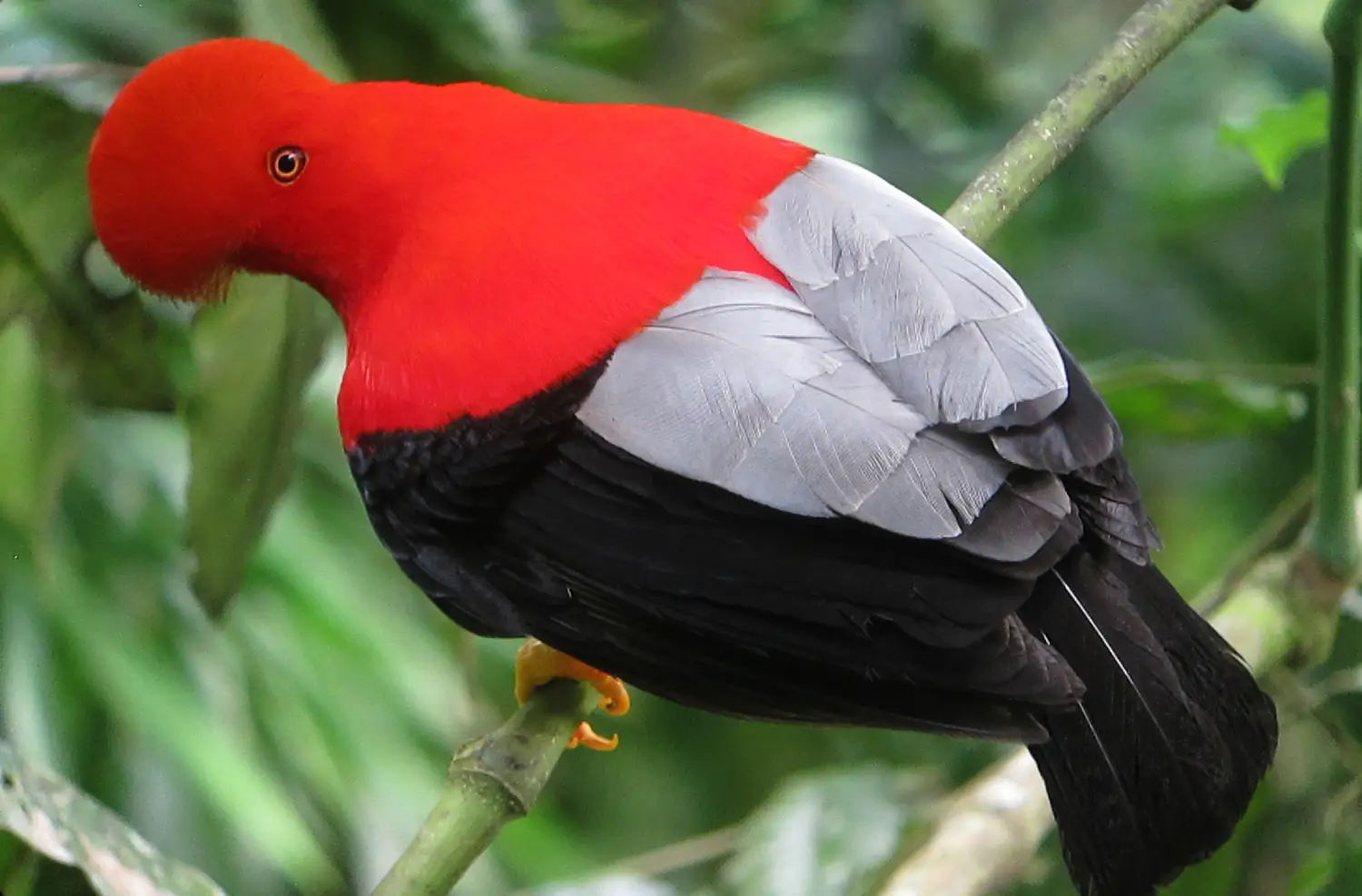
An Andean Cock-of-the-Rock proudly displaying its vivid orange feathers and distinctive crest. Photo by Félix Uribe from Rionegro, Antioquia, Colombia, under the CC BY-SA 2.0 < https://creativecommons.org/licenses/by-sa/2.0 > license, via Wikimedia Commons .
The Marvelous Spatuletail is a truly extraordinary hummingbird, renowned for its dazzling beauty and unique tail feathers. Endemic to Peru, this rare species is found in the cloud forests of the Amazonas region, particularly in the Utcubamba Valley. It is one of the most sought-after birds by birdwatchers and nature enthusiasts visiting the country.
What sets the Marvelous Spatuletail apart is its remarkable tail: males boast two elongated outer feathers tipped with large, iridescent discs or "spatules" that they use in intricate courtship displays. These feathers can be up to three times the length of their body and are a testament to the species’ evolutionary adaptations. During mating rituals, males hover midair, performing acrobatic displays while flicking their spatules in mesmerizing patterns to attract females.
Despite their striking appearance, these hummingbirds are small and delicate, measuring only about 15 cm in total length, including their tail feathers. They feed primarily on nectar from native flowers, playing a vital role as pollinators in their ecosystem, but they also consume insects for protein.
The Marvelous Spatuletail is considered endangered due to habitat loss and its limited range, making conservation efforts crucial. Birdwatchers hoping to catch a glimpse of this jewel should visit the Huembo Reserve or other protected areas in northern Peru, where this species is actively safeguarded. Witnessing the Marvelous Spatuletail in its natural habitat is an unforgettable experience and a highlight of any birding trip to Peru.
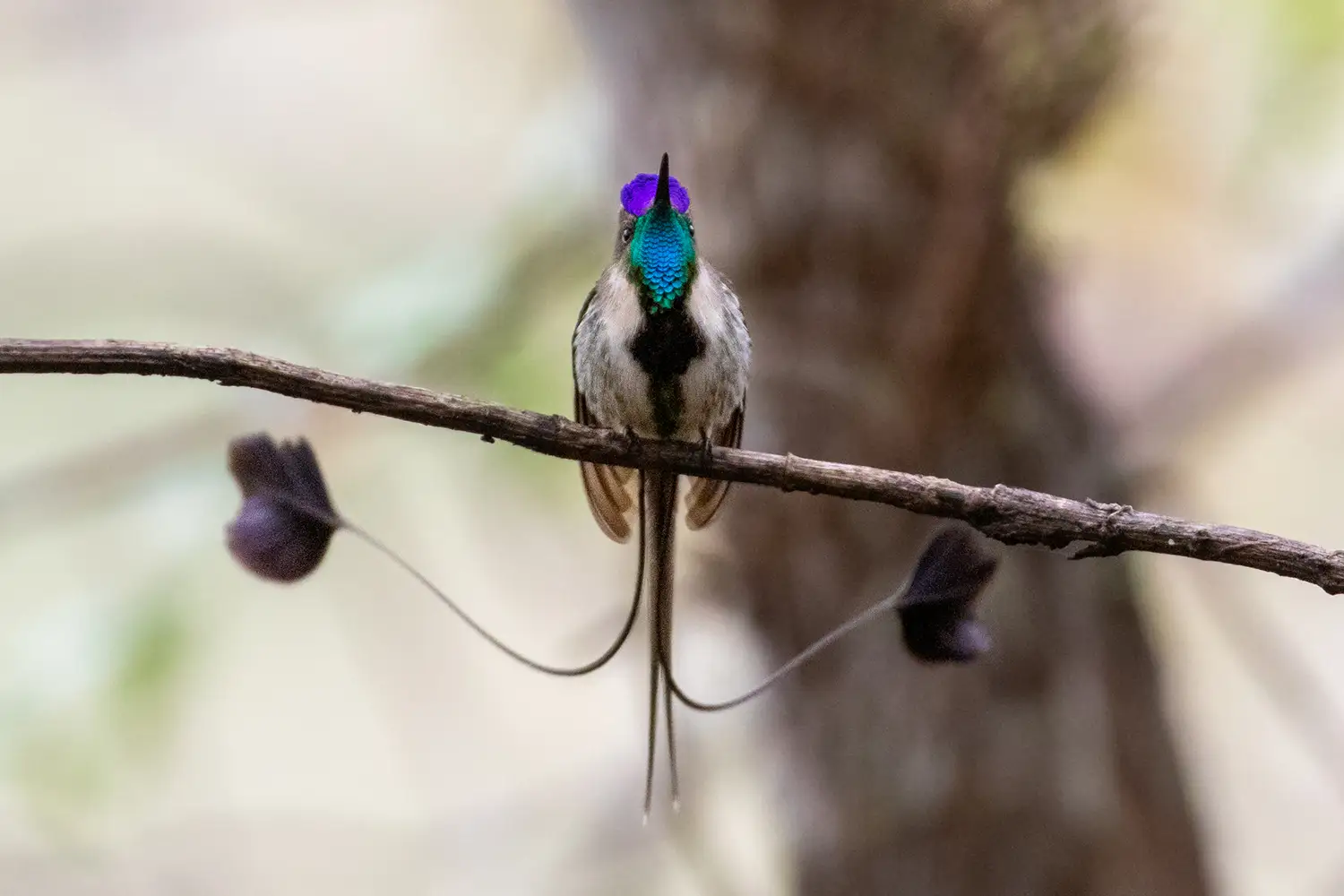
The Marvelous Spatuletail showcasing its vibrant plumage and distinctive spatule-shaped tail feathers. Photo by thibaudaronson, under the CC BY-SA 4.0 < https://creativecommons.org/licenses/by-sa/4.0 > license, via Wikimedia Commons .
The Harpy Eagle is one of the most awe-inspiring raptors in the world, reigning as a top predator in the tropical rainforests of South and Central America. In Peru, this majestic bird inhabits the Amazon Basin, thriving in untouched, dense forests. With its massive size, slate-gray body, striking black-and-white crest, and piercing yellow eyes, it’s a must-see for bird enthusiasts.
Boasting a wingspan of up to 2 meters (6.5 feet) and weighing up to 10 kilograms (22 pounds), the Harpy Eagle is among the largest and most powerful eagles. Its enormous talons, some of the strongest in the animal kingdom, enable it to capture prey nearly half its weight with precision.
Sightings are rare due to its preference for remote habitats and low population density, but Tambopata National Reserve and Manu National Park offer some of the best chances to observe this apex predator. Conservation is vital to protect the Harpy Eagle from threats like habitat destruction. Encountering this iconic bird in the wild is an unforgettable testament to the Amazon's raw beauty and ecological importance.
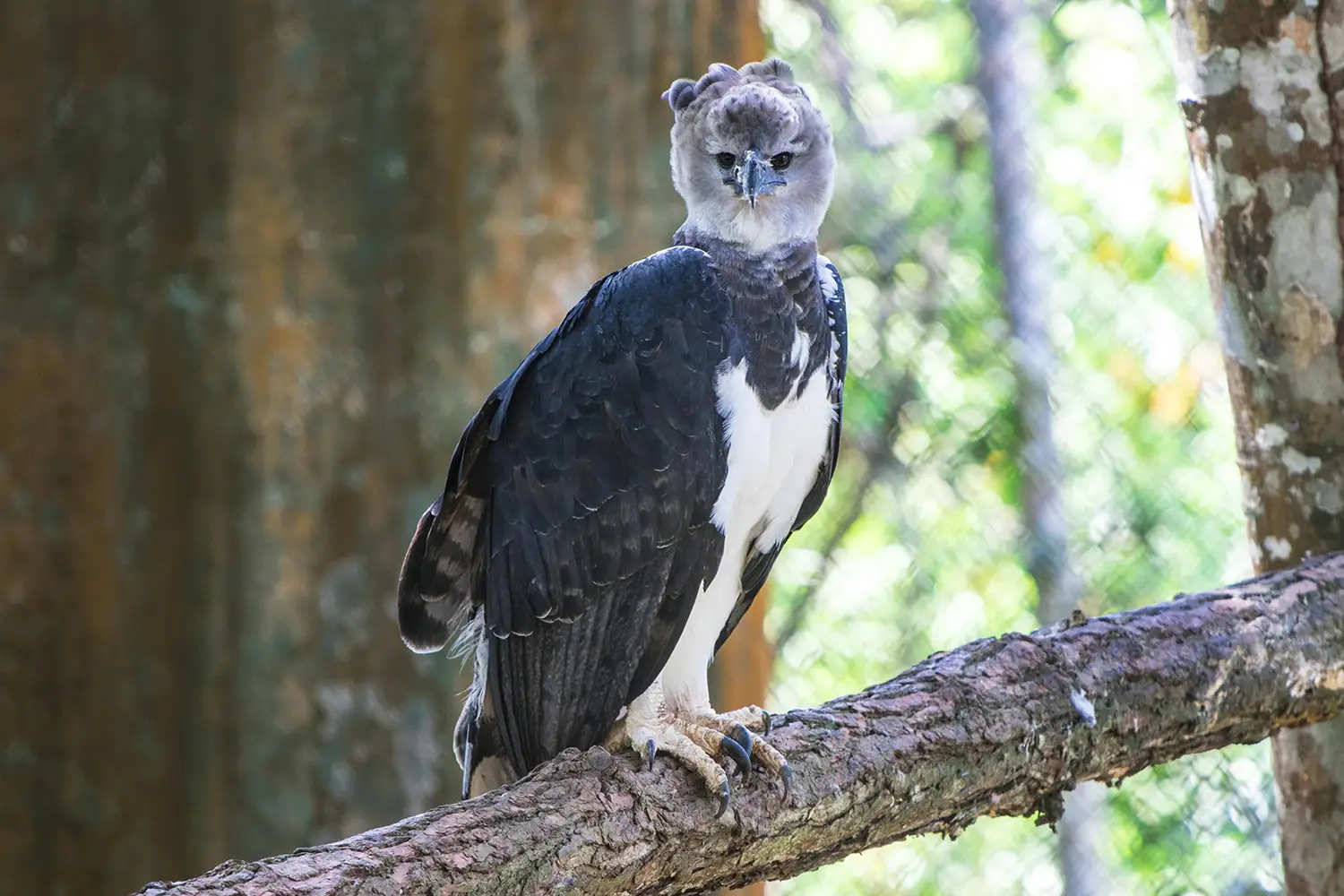
Majestic and powerful: The Harpy Eagle, a symbol of the Amazon's untamed beauty and a true apex predator. Photo by Itiel Cd on Pexels .
The Inca Tern is a striking seabird found along the coast of Peru and northern Chile, known for its dark-gray plumage, white mustache-like feathers, and vibrant orange-yellow beak. Easily recognizable, this captivating bird is often seen hunting fish and small marine creatures in the rocky cliffs and islands of the Humboldt Current.
Inca Terns nest in colonies and are expert divers, gracefully soaring before plunging into the ocean to catch their prey. While elusive, they are a favorite among bird photographers, often perched on rocky outcrops or skimming the water. The best places to spot them in Peru include the Ballestas Islands, Isla de los Lobos, and northern coastal cliffs.
Though widespread, Inca Terns are considered vulnerable due to habitat loss and fishing pressures, making sightings of these magnificent birds even more special.
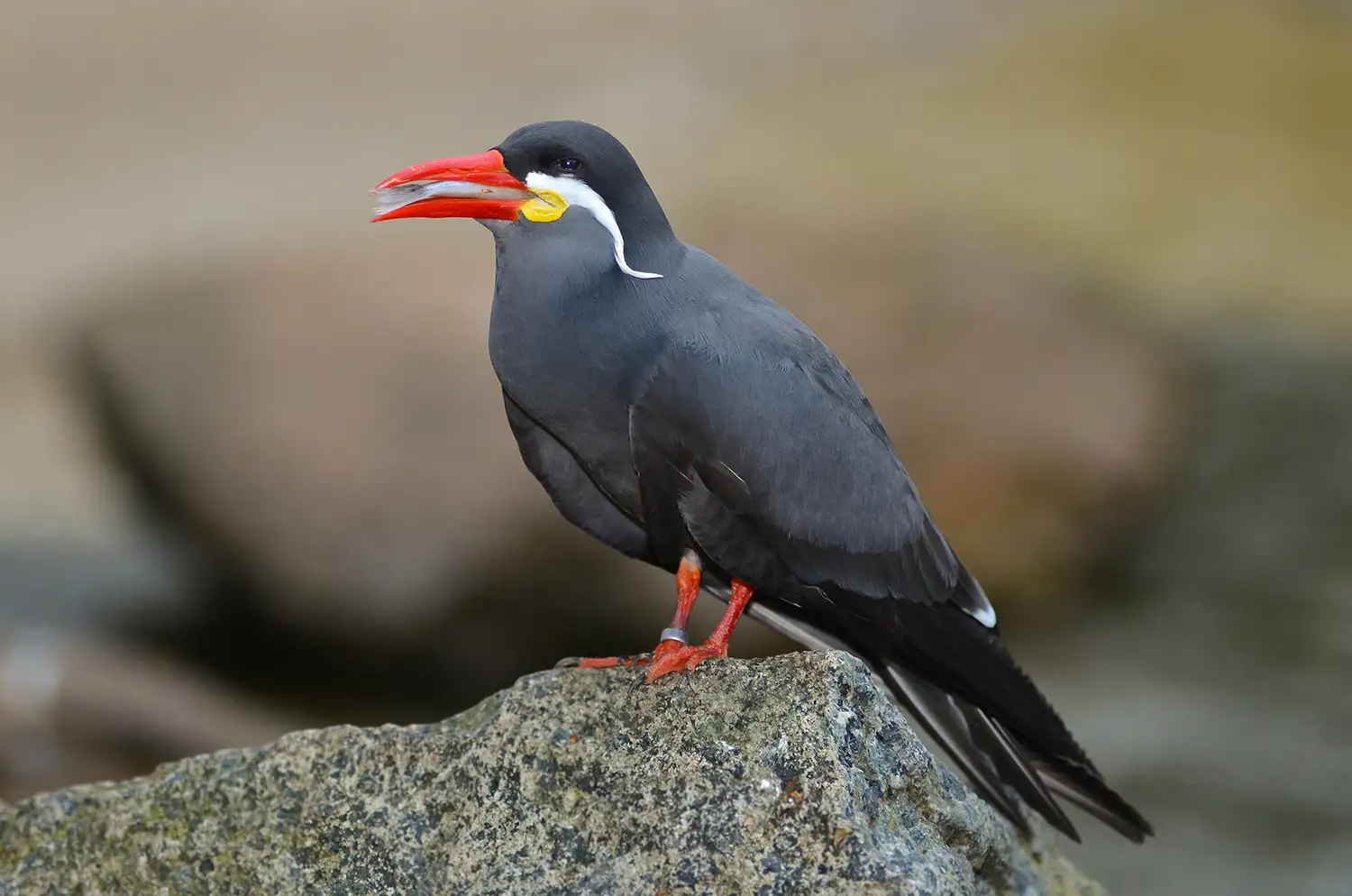
The Inca Tern, a striking seabird with dark-gray plumage and distinctive white mustache-like feathers. Photo by Olaf Oliviero Riemer, under the CC BY-SA 3.0 < https://creativecommons.org/licenses/by-sa/3.0 > license, via Wikimedia Commons .
The Giant Hummingbird is a remarkable species that stands out as the largest hummingbird in the world. Native to the highland regions of South America, including Peru, this magnificent bird can be found at altitudes ranging from 1,500 to 4,000 meters (4,920 to 13,120 feet) above sea level, particularly in the Andean valleys. Its rarity and impressive size make it a sought-after sight for bird enthusiasts exploring the diverse ecosystems of Peru’s mountains.
The Giant Hummingbird measures about 20 cm (8 inches) in length, weighs around 20–22 grams (0.7–0.8 ounces), and has a wingspan of about 24 cm (9.5 inches), nearly double the size of most other hummingbird species. Despite its name, it is still small by bird standards but significantly larger than its relatives. Its plumage is mostly a shimmering bronze-green with a striking white underbelly and a long, graceful tail. This large hummingbird also has a robust, slightly curved bill that is perfectly adapted to sipping nectar from a variety of high-altitude flowers, such as those found in the polylepis forests.
A fascinating feature of the Giant Hummingbird is its ability to hover in place, a behavior common among hummingbirds, which it uses to feed on nectar while hovering over flowers. It also forages for insects to supplement its diet, making it an important part of the ecosystem in the Andes. Its large size enables it to migrate across long distances, often traveling to different elevations based on seasonal changes.
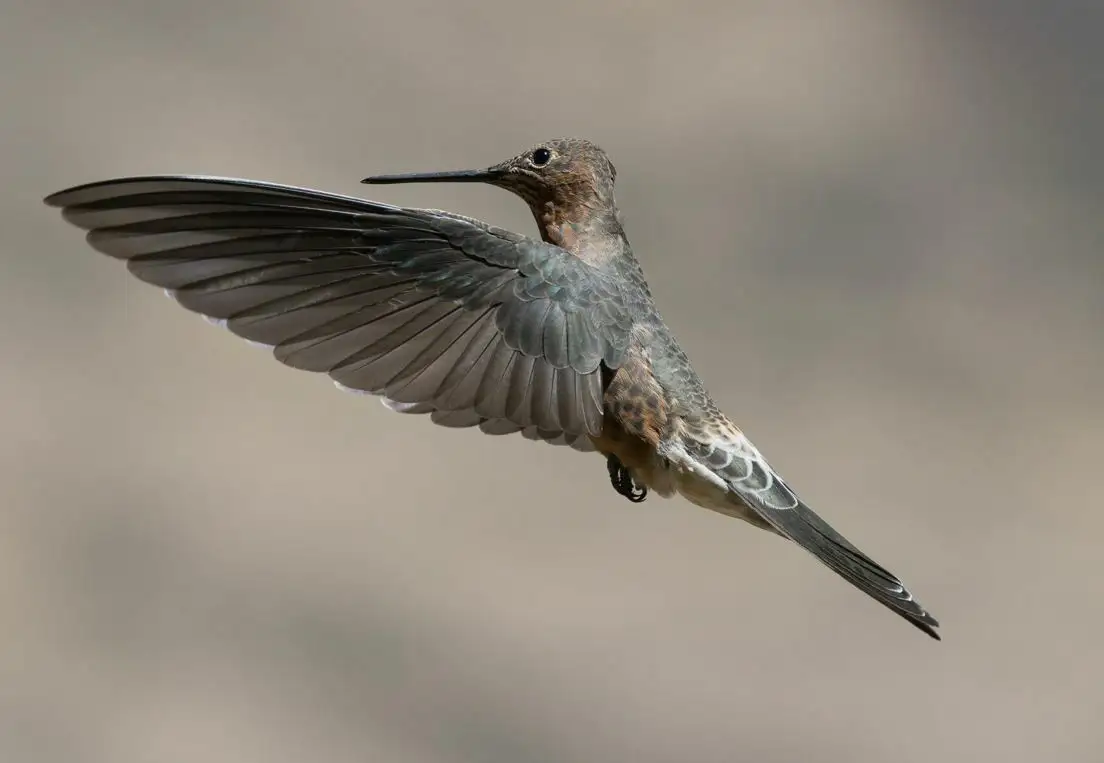
The Giant Hummingbird captivates with its impressive size and shimmering bronze-green plumage, making it a true gem of Peru’s highlands. Photo by Claude Kolwelter, under the CC BY 4.0 < https://creativecommons.org/licenses/by/4.0 > license, via Wikimedia Commons .
The Hoatzin, often referred to as the "stink bird" or "canje pheasant," is one of the most fascinating and unique bird species found in the Amazon rainforest. Known for its prehistoric appearance and peculiar behavior, the Hoatzin has a lineage that sets it apart from other birds, earning it the nickname "living fossil."
This instantly recognizable bird has a vibrant plumage of chestnut, cream, and streaked black feathers. It has a blue face, striking red eyes, and a spiky crest of feathers that give it a regal yet quirky appearance. Juvenile Hoatzins are even more remarkable, as they have small claws on their wings, a feature reminiscent of early avian ancestors. These claws are used for climbing trees before they develop the ability to fly.
The Hoatzin's diet is predominantly herbivorous, consisting of leaves, flowers, and fruits. It has a highly specialized digestive system that ferments vegetation in its crop, much like a cow's stomach. This unique process produces a strong odor, which has led to its nickname, "stink bird."
The Hoatzin is a social bird, often seen in small groups perched along branches near water. Its clumsy flight and guttural calls add to its charm, making it a favorite among visitors to the Amazon Basin. For bird enthusiasts, observing the Hoatzin in its natural habitat is a glimpse into the evolutionary history of birds, offering a truly unforgettable experience.
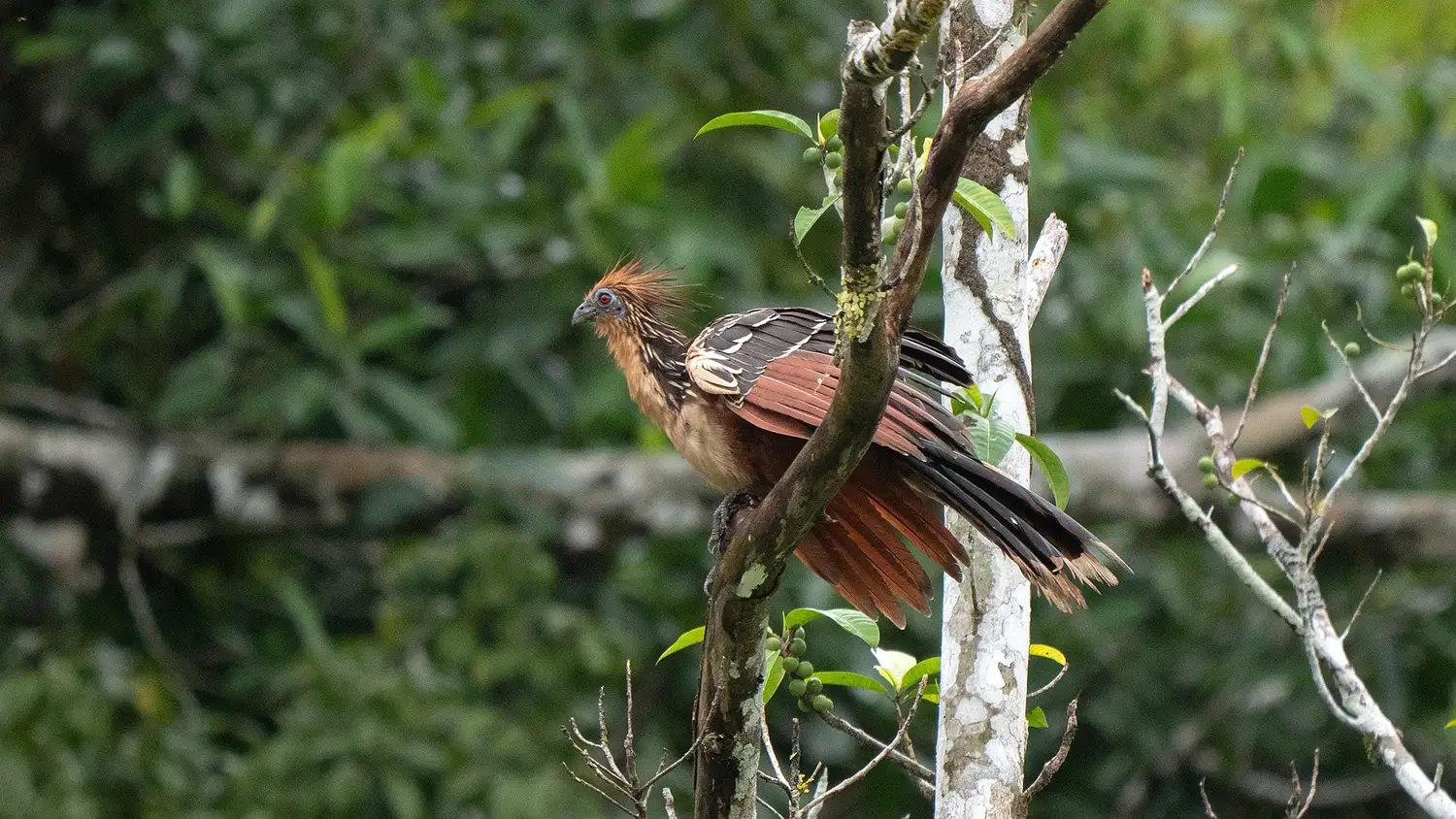
With its striking plumage and prehistoric appearance, the Hoatzin, often called the 'stinkbird,' is a fascinating resident of Peru's Amazon rainforests. Photo by hbieser on Pixabay .
The Andean Condor is one of the most iconic and majestic birds of South America, symbolizing power and freedom in Andean culture. With a wingspan of up to 3.3 meters (10.8 feet), it is the largest flying bird in the world, making it an awe-inspiring sight as it soars effortlessly over the rugged landscapes of Peru.
These remarkable birds inhabit the high-altitude regions of the Andes, favoring open grasslands, cliffs, and mountainous terrains that provide the perfect conditions for their soaring flight. The Andean Condor’s striking appearance is characterized by black plumage with white feathers forming a distinctive collar around its neck. Adult males stand out with a prominent bald head and a fleshy comb on top, which can change color depending on their emotional state.
The condor is a scavenger, relying on its exceptional vision to locate carrion from great distances. Its ecological role as nature's cleaner is vital to the health of its environment. Despite its large size, the Andean Condor is a master of energy efficiency, using thermal air currents to glide for hours without flapping its wings.
Witnessing an Andean Condor in flight is a truly unforgettable experience, offering a connection to the vast beauty and history of the Andes.
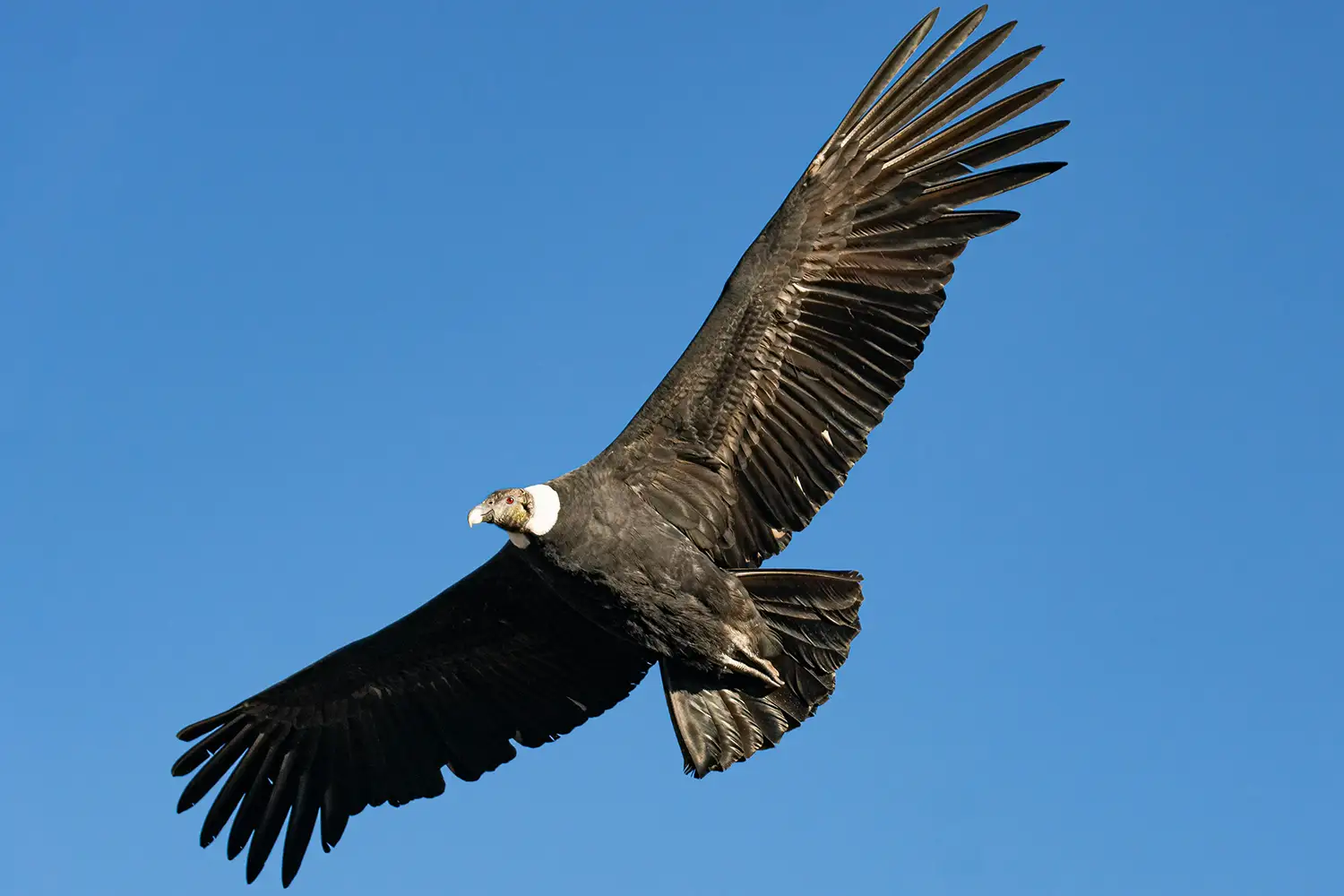
Majestic and iconic, the Andean Condor soars high above Peru's mountains, symbolizing the spirit of the Andes. Photo by Shanai Edelberg on Pexels .
The Humboldt Penguin is a charming and resilient species native to the coasts of Peru and Chile, named after the nutrient-rich Humboldt Current that sustains its habitat. These medium-sized penguins are a fascinating sight, with their black-and-white tuxedo-like plumage, pinkish patches around their eyes, and a distinctive black horseshoe-shaped band across their chest.
Humboldt Penguins inhabit rocky coastal areas, including islands and cliffs, where they nest in burrows or crevices. They rely on the cold waters of the Humboldt Current, teeming with fish like anchovies and sardines, which form the bulk of their diet. Expert swimmers, these penguins can dive to depths of up to 50 meters (164 feet) to hunt, using their streamlined bodies and powerful flippers to propel themselves through the water.
Despite their adaptability, Humboldt Penguins face numerous threats, including habitat loss, overfishing, and climate change, which impacts their food sources. Conservation efforts, such as protected marine reserves and eco-tourism initiatives, are critical to their survival.
Watching these endearing penguins waddle along rocky shores or glide gracefully in the ocean is a delight for wildlife enthusiasts. Their presence along Peru's coastline is a reminder of the rich biodiversity sustained by the Humboldt Current and a testament to nature's resilience.

Adorable and agile, the Humboldt Penguin thrives along Peru's rocky coasts, a charming resident of the cold Humboldt Current. Photo by minka2507 on Pixabay .
The Curl-crested Aracari is one of the most striking and colorful members of the toucan family, distinguished by its unique curly feathers on the crown of its head, which resemble a textured mosaic. Found primarily in the lowland rainforests of the Amazon Basin, including parts of eastern Peru, this bird is a true gem of the region’s diverse ecosystem.
This medium-sized aracari boasts vibrant plumage, with a black head, crimson belly, and greenish-yellow back. Its large, multicolored bill is both an essential tool for feeding and a defining characteristic that adds to its captivating appearance. The most unique feature, however, is the bird’s namesake: the curly, glossy feathers on its head, which appear almost scale-like under sunlight.
Curl-crested Aracaris inhabit the upper canopy of tropical forests, where they feed on fruits, seeds, and occasionally insects. Their social nature makes them often seen in small flocks, flying between trees or perching together while calling out in sharp, high-pitched tones. They play a vital role in their habitat as seed dispersers, helping to maintain the health and diversity of the rainforest.
Due to habitat loss and deforestation, the Curl-crested Aracari faces threats to its population. However, conservation initiatives aimed at protecting Peru’s Amazon rainforests are crucial in safeguarding the future of this species. Spotting a Curl-crested Aracari in the wild is a moment to treasure, as it offers a glimpse into the incredible biodiversity of the Amazon.
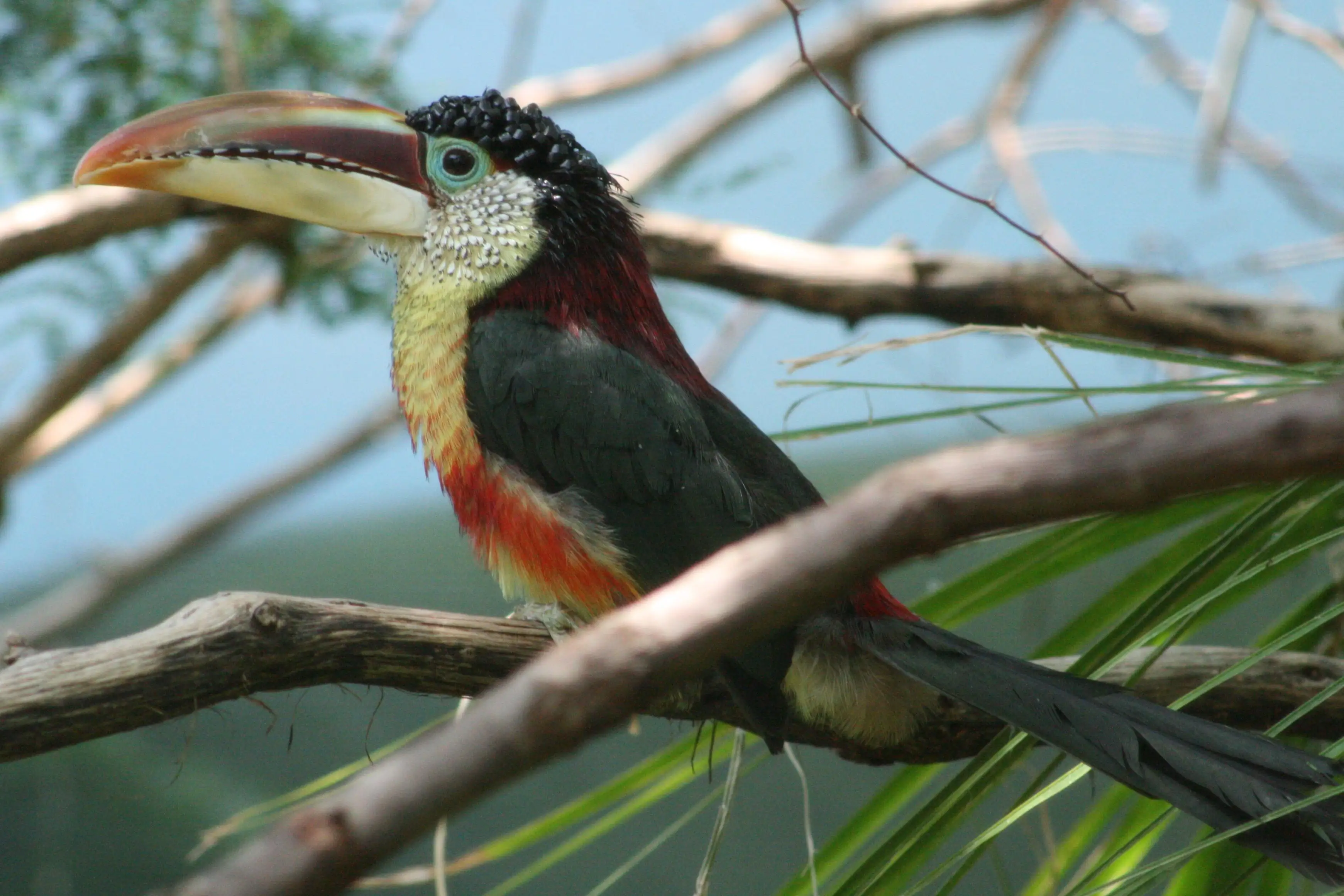
Vibrant and playful, the Curl-crested Aracari showcases its striking feathered crest and colorful plumage, a true gem of the rainforest canopy. Photo by Lonnie Huffman, under the CC BY 3.0 < https://creativecommons.org/licenses/by/3.0 > license, via Wikimedia Commons .
The Scarlet Macaw is one of the most iconic and colorful birds in the world, known for its brilliant red, yellow, and blue plumage that makes it a striking sight in the rainforests of Central and South America.
Scarlet Macaws are large, with a wingspan of up to one meter (about three feet), and are easily recognizable by their vivid coloration. The bird’s striking appearance is complemented by its large, powerful beak, which is perfectly suited for cracking open nuts and seeds, its primary food source. Their diet also includes fruits, berries, and insects. These parrots are often seen in pairs or small groups, communicating with loud calls and screeches that echo through the forest as they fly from tree to tree.
In addition to their beauty, Scarlet Macaws are highly intelligent and social birds. They form strong bonds with their mates and are known for their complex behaviors, including mimicking sounds and demonstrating problem-solving abilities. Their nesting sites are often in tall trees, where they build nests in the hollows of trunks or branches, away from predators.
Spotting a Scarlet Macaw in the wild is a breathtaking experience, as these colorful creatures take flight against the backdrop of the lush rainforest. For birdwatchers and nature lovers, encountering a Scarlet Macaw in Peru is a highlight of any Amazonian adventure.
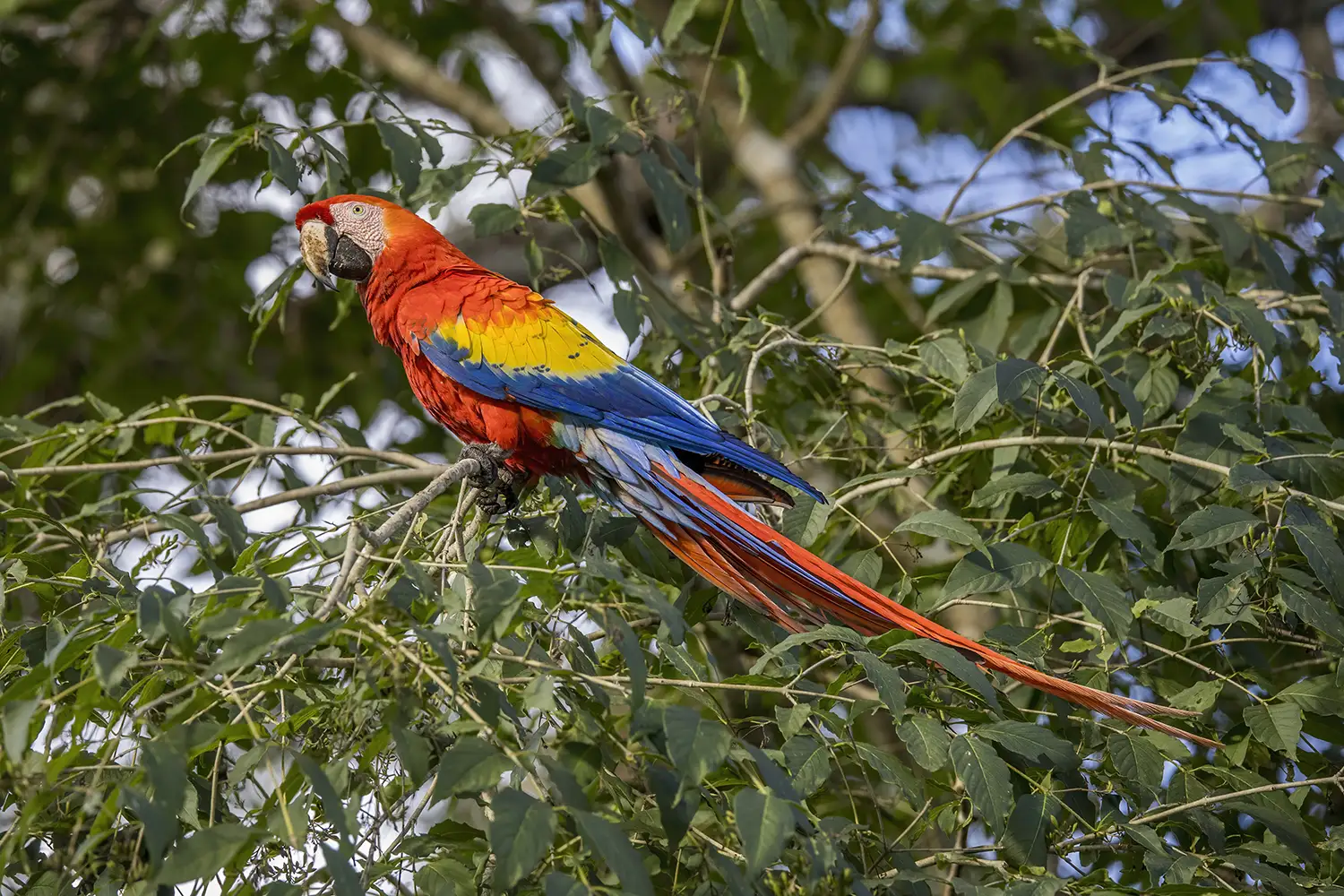
With its vibrant red, yellow, and blue plumage, the Scarlet Macaw is a dazzling icon of Peru's Amazon rainforest. Photo by Charles J. Sharp, under the CC BY-SA 4.0 < https://creativecommons.org/licenses/by-sa/4.0 > license, via Wikimedia Commons .
Peru is home to an astonishing number of bird species, many of which are found nowhere else on Earth. These endemic birds are a testament to the country's diverse ecosystems, from the cloud forests of the Andes to the arid coastal deserts. Below are some of Peru's most fascinating endemic species:
The Peruvian Plantcutter is a rare and fascinating bird found exclusively in the dry forests of northwestern Peru. As one of the few strictly herbivorous bird species in the world, it stands out for its unique diet, feeding primarily on leaves, buds, and flowers. Its distinctive name comes from its habit of “cutting” leaves with its beak to consume them.
Male Peruvian Plantcutters are strikingly marked, with a rufous chest, a gray crown, and a contrasting black mask, while females are more subdued in coloration, blending into their arid environment.
Conservation programs are working to protect the dry forest habitat essential for the survival of the Peruvian Plantcutter, making it a symbol of the need for sustainable land use in the region. For birdwatchers, spotting this elusive species is a rare and rewarding experience.
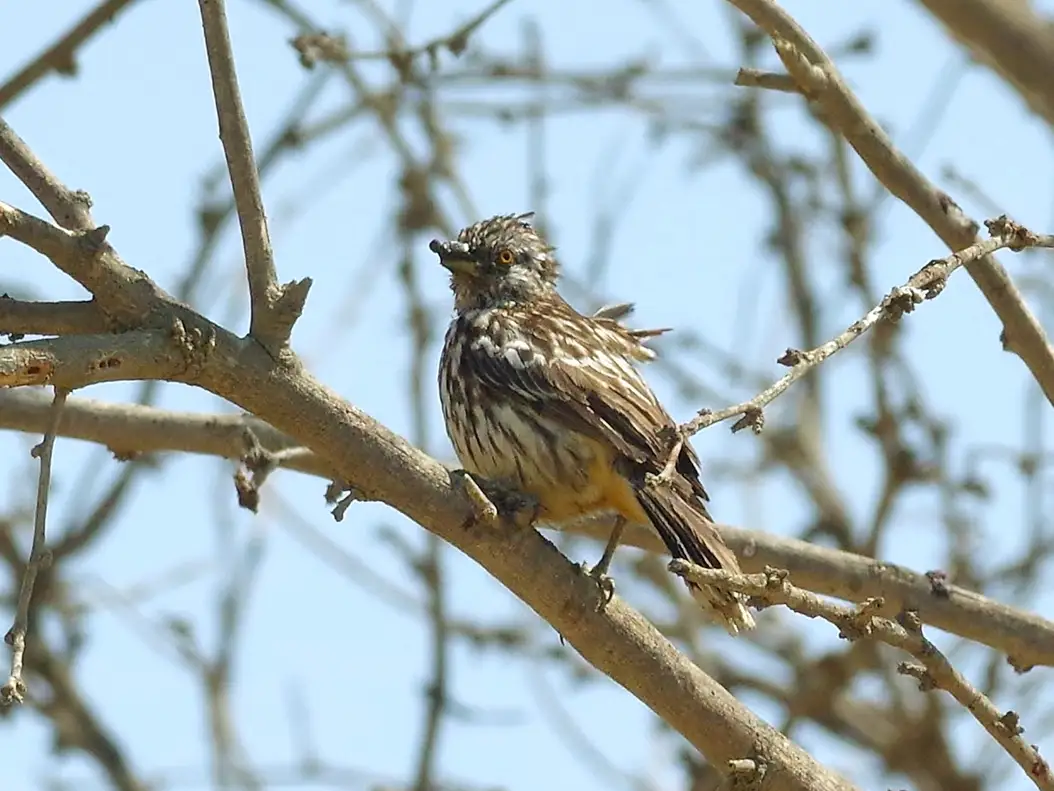
A female Peruvian Plantcutter, with its subtle brown and rufous tones, is a rare gem found in the dry forests of northern Peru. Photo by thibaudaronson, under the CC BY-SA 4.0 < https://creativecommons.org/licenses/by-sa/4.0 > license, via Wikimedia Commons .
The White-winged Guan is a species endemic to the dry forests of northern Peru. This large, turkey-like bird is easily recognized by its dark plumage, striking white wing patches, and vibrant red throat pouch, which is most noticeable during the breeding season.
Once believed to be extinct for nearly a century, the White-winged Guan was rediscovered in 1977, sparking a renewed effort to protect this rare species. These birds inhabit dense forests and feed on fruits, leaves, and seeds, playing an important ecological role as seed dispersers.
Conservation programs, including habitat restoration and captive breeding initiatives, have helped stabilize their population in recent years, but habitat loss and hunting remain persistent threats. For birdwatchers, the White-winged Guan is a highly sought-after sighting, offering a glimpse into Peru's unique and fragile biodiversity.
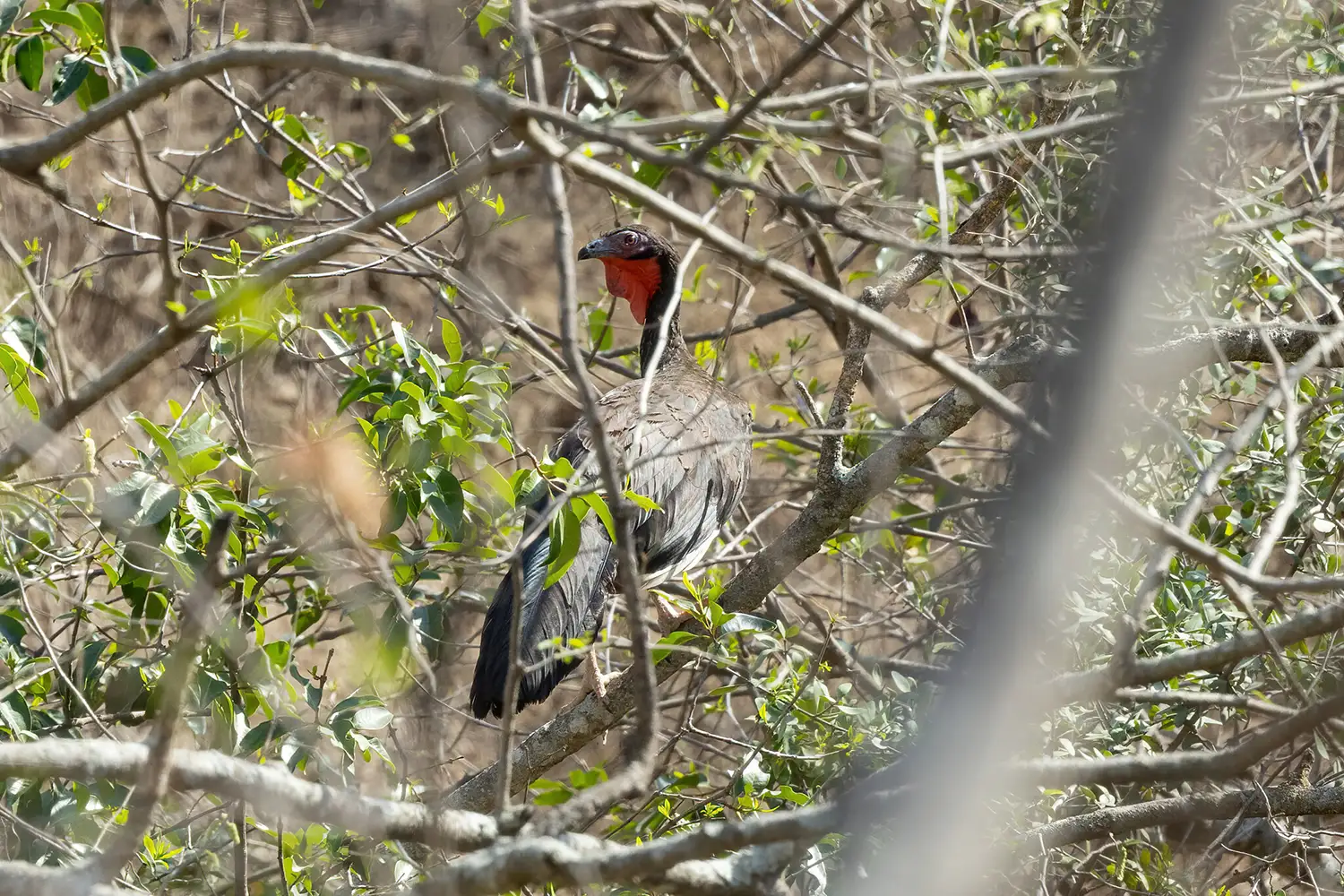
The White-winged Guan, an endangered species native to northern Peru. Photo by Thibaud Aronson, under the CC BY-SA 4.0 < https://creativecommons.org/licenses/by-sa/4.0 > license, via Wikimedia Commons .
The Junin Grebe is a bird found exclusively in Lake Junín , located high in the Andes of central Peru. This striking grebe is non-migratory and entirely aquatic, relying on the lake’s open waters and reed-lined edges for survival. It's distinguished by its stout body, dark plumage, and a distinctive white cheek patch with a black crown. Its long, slender neck and sharp, pointed bill make it well-suited for diving and catching prey. During the breeding season, the grebe’s head becomes adorned with vibrant red and yellow coloring, enhancing its striking appearance.
Unfortunately, the Junin Grebe faces severe threats due to its highly restricted range and dependence on Lake Junín’s delicate ecosystem. Pollution, water level fluctuations from human activity, and invasive species have contributed to a decline in its population, which is now estimated to be fewer than 300 individuals.
Conservation efforts are focused on habitat protection and reducing pollution in the lake. For birdwatchers and conservationists, spotting a Junin Grebe is a rare privilege, offering a chance to witness one of the world’s most unique and vulnerable bird species.
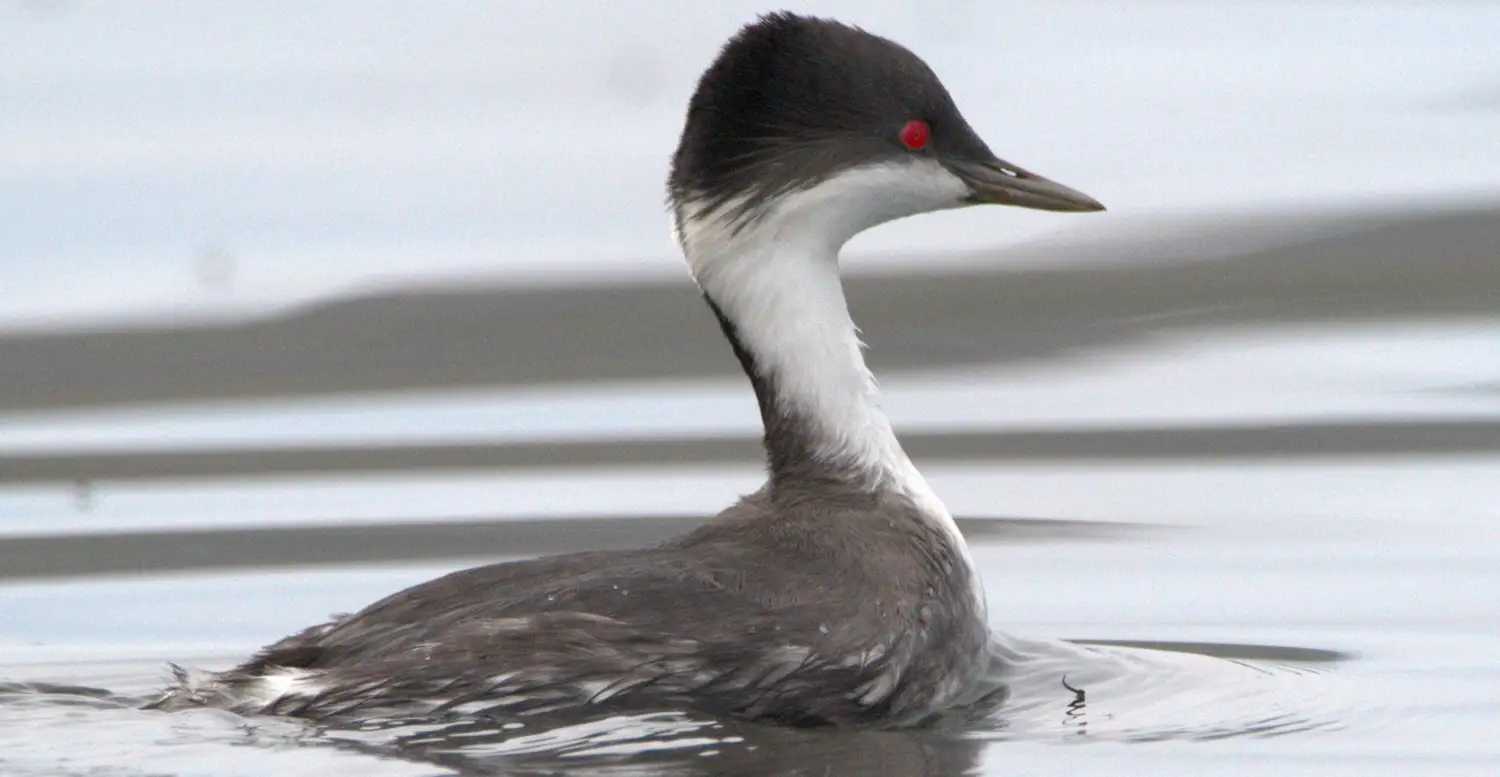
The Junin Grebe, a critically endangered bird found only in Peru's Junin Lake. Photo by Birdingperu, under the CC BY-SA 4.0 < https://creativecommons.org/licenses/by-sa/4.0 > license, via Wikimedia Commons , cropped to 50% from original size.
The Black-necked Woodpecker is a striking and rare bird found in the dry forests and woodlands of western Peru. This medium-sized woodpecker is easily recognizable by its black neck and nape, contrasting sharply with its golden-yellow body and white underparts. The bird also features a distinctive red patch on its crown, which adds to its colorful appearance.
The Black-necked Woodpecker feeds primarily on insects and larvae found in the trunks of trees, which it extracts with its strong, chisel-like beak. This species is important for controlling insect populations and contributes to the ecological balance of its environment.
Unfortunately, the Black-necked Woodpecker faces threats from habitat destruction due to agriculture and urbanization. As a result, conservation efforts are ongoing to preserve its natural habitat.
Quick Facts on the Black-necked Woodpecker
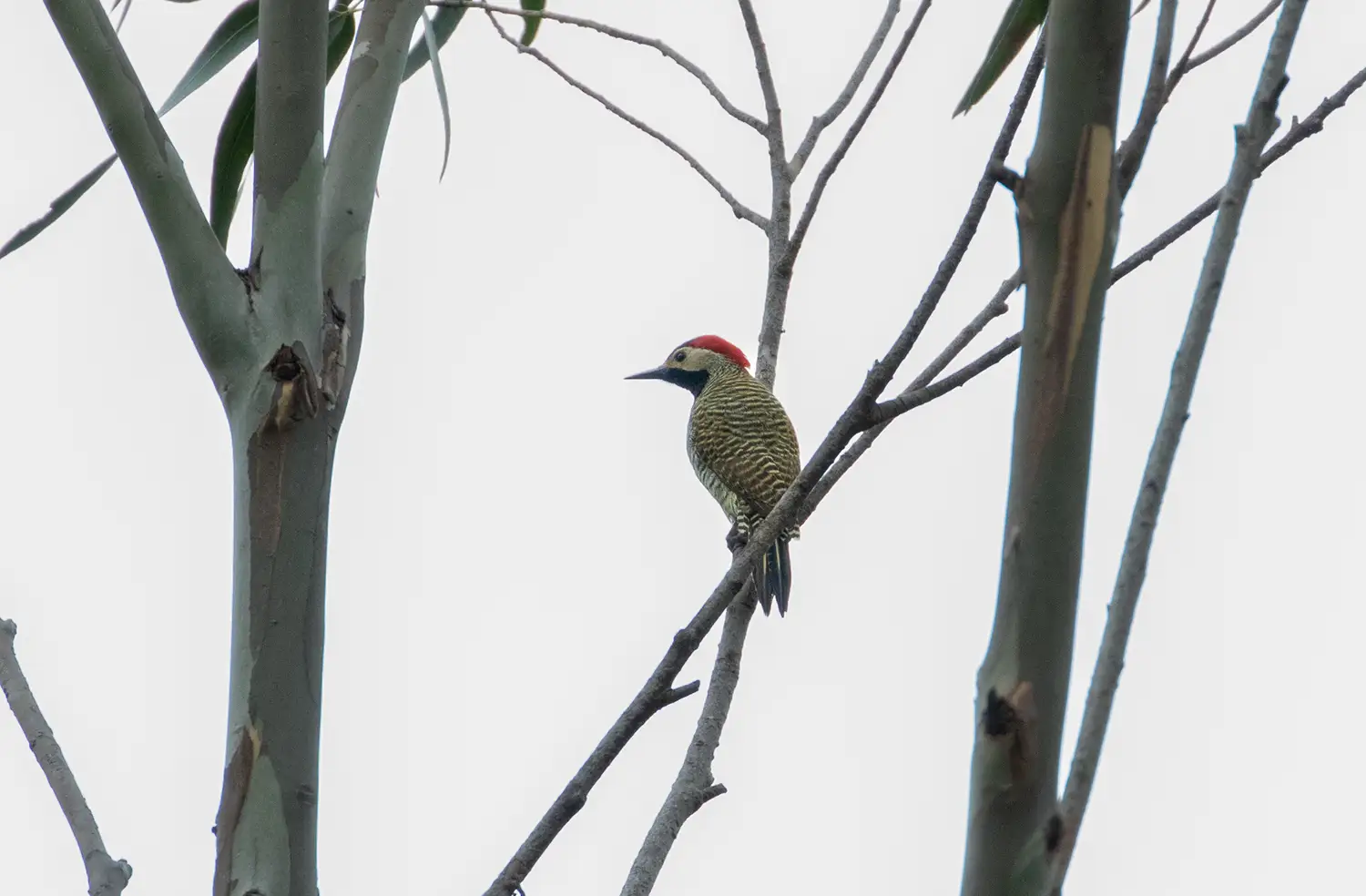
Striking and elusive, the Black-necked Woodpecker is a captivating bird found in the forests of Peru, known for its distinctive black and white plumage. Photo by Thibaud Aronson, under the CC BY-SA 4.0 < https://creativecommons.org/licenses/by-sa/4.0 > license, via Wikimedia Commons .
The Long-whiskered Owlet is one of the most elusive and extraordinary birds in Peru, often regarded as one of the most difficult owls to spot in the world. This tiny, nocturnal species is endemic to the cloud forests of the eastern slopes of the Andes. Known for its distinctive long, white whisker-like feathers on either side of its face, this owl has a round body with a mix of brown and gray plumage, blending seamlessly into its forested surroundings.
The Long-whiskered Owlet was only discovered in 1976 and remains one of the rarest owls in the world. It feeds primarily on insects and small invertebrates that it catches during the night. Due to its highly specialized habitat requirements and its nocturnal behavior, it is rarely seen by birdwatchers.
Under threat due to habitat destruction and fragmentation, particularly from deforestation in the cloud forest region, conservation efforts are focused on preserving the fragile ecosystems that support this unique species. For avid birdwatchers, encountering the Long-whiskered Owlet is a true gem, offering a rare opportunity to witness a marvel of Peru’s avian diversity.
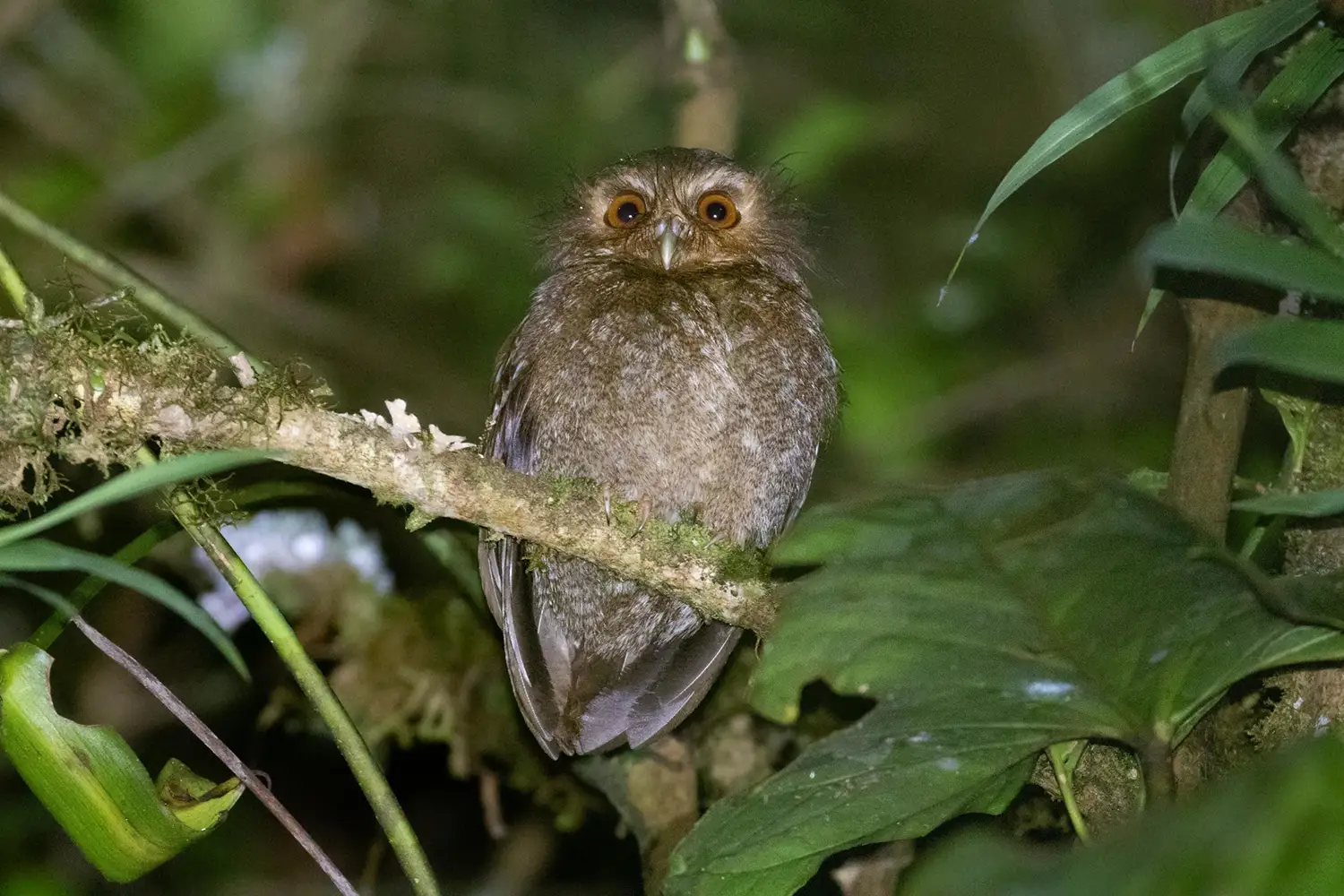
With its charming long whiskers and vibrant plumage, the Long-whiskered Owlet is one of Peru's most elusive and fascinating nocturnal birds. Photo by thibaudaronson, under the CC BY-SA 4.0 < https://creativecommons.org/licenses/by-sa/4.0 > license, via Wikimedia Commons .
The Purple-backed Sunbeam is a stunning hummingbird endemic to the high-altitude regions of the Peruvian Andes. Known for its dazzling purple back, which contrasts beautifully with its emerald-green plumage and white underparts, this species is a favorite among birdwatchers.
This hummingbird inhabits the high grasslands and paramo ecosystems, typically found at altitudes ranging from 3,000 to 4,500 meters (9,800 to 14,800 feet). It feeds on nectar from a variety of alpine flowers, using its long, specialized bill to extract nectar while also assisting in pollination.
Despite its beauty, this hummingbird faces threats from habitat loss due to agricultural expansion and climate change, and efforts are underway to protect its fragile high-altitude habitat. For birdwatchers, spotting this dazzling species is a rare and rewarding experience in the pristine Andean highlands of Peru.

An endemic treasure of Peru, the Purple-backed Sunbeam dazzles with its iridescent plumage. Photo by Carole Turek, under the CC BY-SA 4.0 < https://creativecommons.org/licenses/by-sa/4.0 > license, via Wikimedia Commons .
The Rufous Flycatcher is a striking bird found in the subtropical and tropical forests of western Peru. This medium-sized flycatcher is characterized by its rich, rufous-colored underparts, with a contrasting, darker, brownish-gray back and a slight crest on its head.
The Rufous Flycatcher thrives at mid-elevations, typically between 1,500 and 2,500 meters (4,900 to 8,200 feet), where it prefers the forest edges, clearings, and open woodlands. It feeds primarily on insects, which it catches in midair or by swooping down from perches to snatch them off the ground. Known for its agile flight, the Rufous Flycatcher is highly adept at catching flying insects, making it a key part of its ecosystem in controlling pest populations.
The Rufous Flycatcher is increasingly vulnerable due to habitat destruction caused by agriculture and deforestation. Birdwatchers exploring Peru’s forested regions, particularly in areas like the foothills of the Andes and the cloud forests, may be fortunate enough to spot this vibrant and energetic species.
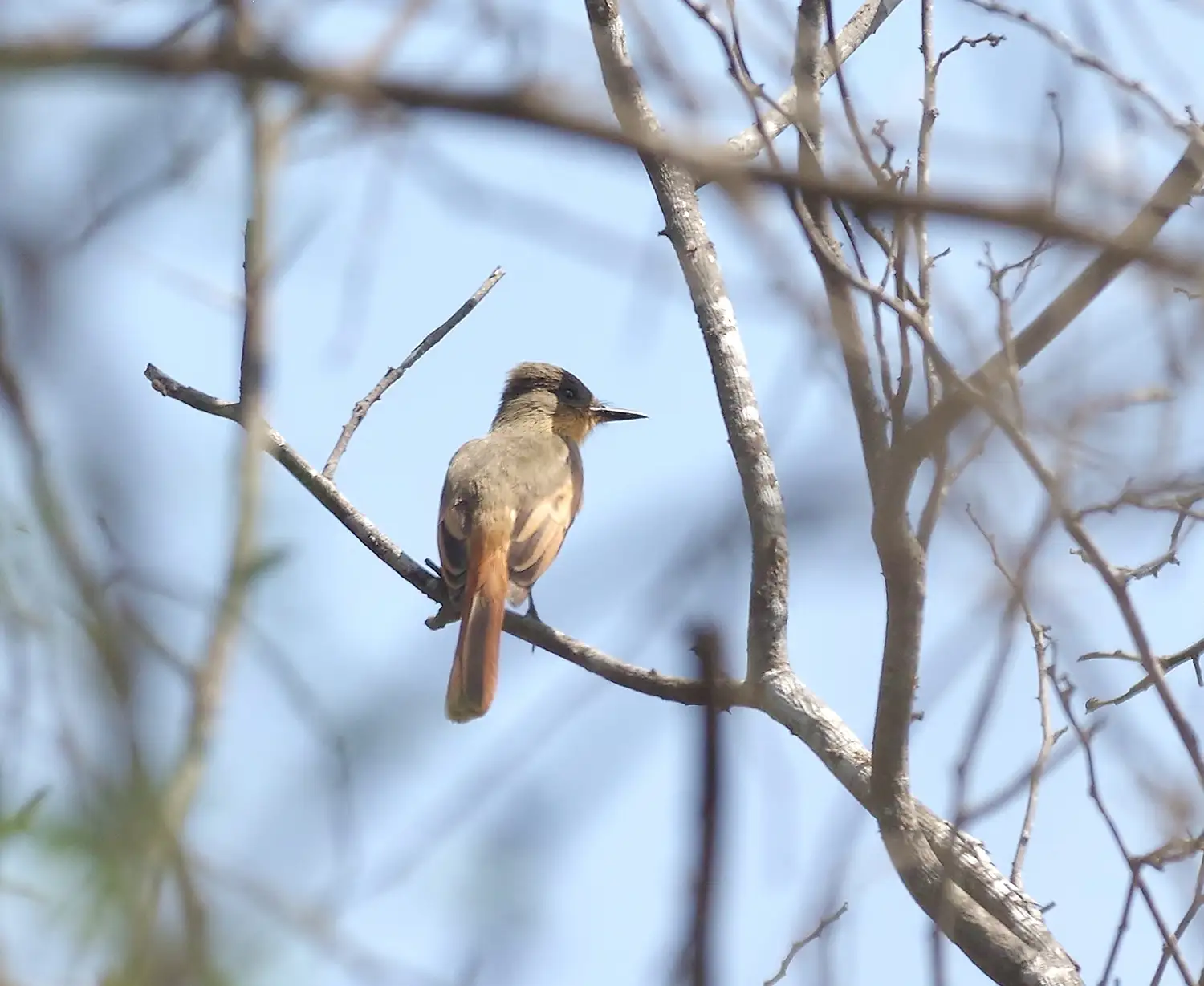
The Rufous Flycatcher is a charming sight for birdwatchers in the forests and woodlands of Peru. Photo by thibaudaronson, under the CC BY-SA 4.0 < https://creativecommons.org/licenses/by-sa/4.0 > license, via Wikimedia Commons .
The Pale-tailed Canastero is a small, secretive bird endemic to the arid, high-altitude regions of the Peruvian Andes. Characterized by its subtle, yet distinctive plumage, this species has a pale brownish-gray body, with a slightly darker crown and a pale, almost white tail, which gives it its name.
Typically found at altitudes between 3,000 and 4,500 meters (9,800 to 14,800 feet), the Pale-tailed Canastero inhabits the puna grasslands and montane scrublands, where it feeds primarily on insects, seeds, and small invertebrates. This canastero species is often spotted foraging on the ground or in low shrubbery.
Due to its preference for remote, high-altitude habitats, the Pale-tailed Canastero remains relatively elusive, often staying hidden within dense vegetation or rocky outcrops. Birdwatchers in the Peruvian highlands can often catch a glimpse of this elusive bird by visiting its natural habitat, which remains one of the more pristine environments in the country. Its distinct appearance and secretive nature make it a rewarding species to encounter.
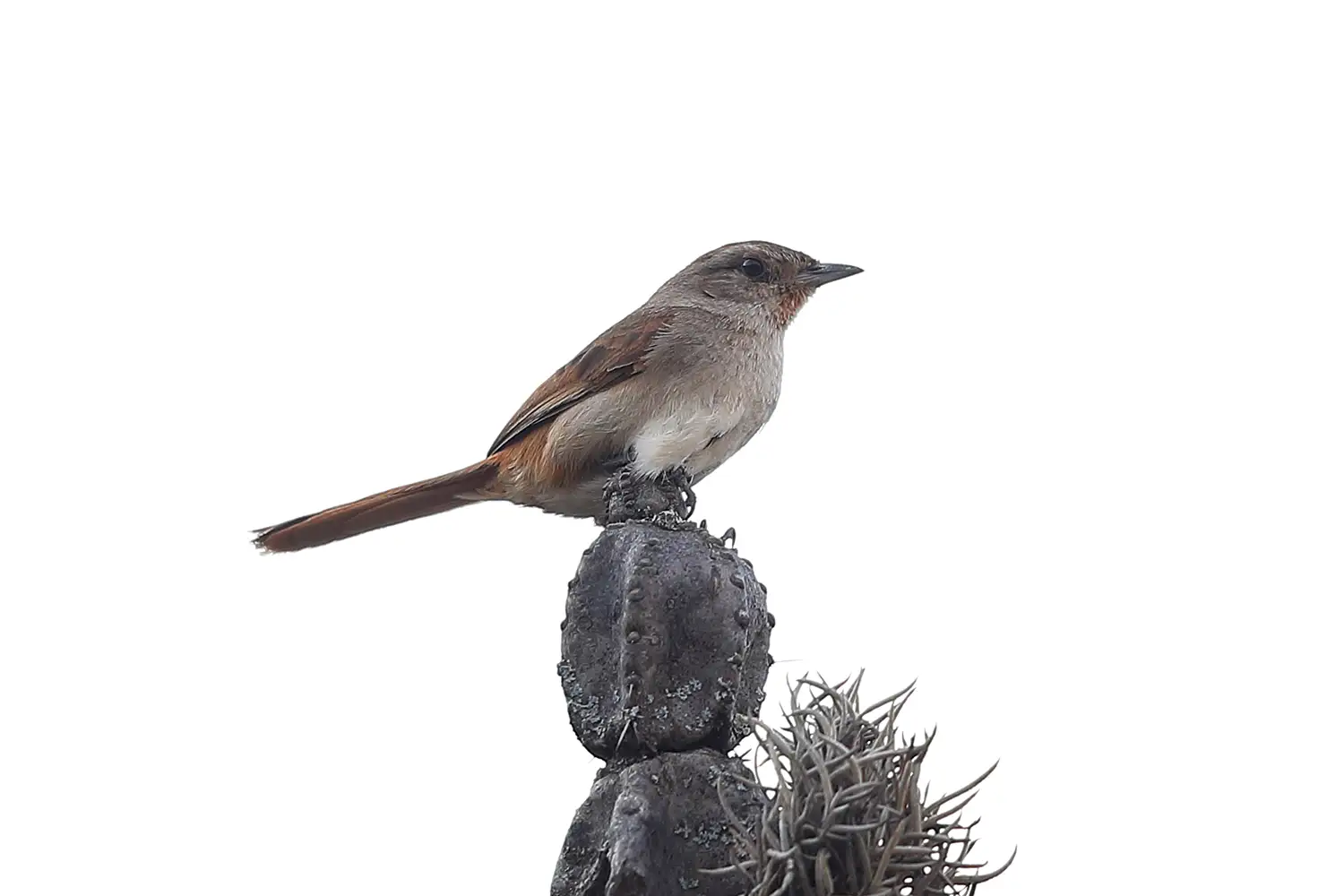
The Pale-tailed Canastero is a small, secretive bird known for its distinctive pale tail and elusive nature. Photo by Jon Irvine, under the CC BY-SA 2.0 < https://creativecommons.org/licenses/by-sa/2.0 > license, via Wikimedia Commons .
The White-bellied Cinclodes is one of Peru’s rarest and most striking endemic birds. Found only in a few high-altitude locations in the central Peruvian Andes, this species is often referred to as a flagship for conservation efforts in puna grassland ecosystems.
This medium-sized bird is distinguished by its bold white underparts, contrasting with its dark brown upperparts and wings. A prominent white stripe above its eye and a slightly curved bill add to its striking profile. The White-bellied Cinclodes is most often observed near wetlands, streams, and boggy areas at altitudes ranging from 4,200 to 4,900 meters (13,800 to 16,000 feet), where it forages for insects and small invertebrates among mosses and rocky terrain.
This species faces severe threats due to its extremely limited range and ongoing habitat loss. Its survival relies on pristine wetlands, which are increasingly endangered by activities such as grazing, mining, and the impacts of climate change. Conservation efforts focus on protecting these fragile ecosystems, making the White-bellied Cinclodes a symbol of high-altitude biodiversity.
The White-bellied Cinclodes stands as a reminder of the delicate balance between species survival and habitat preservation, and for avid birdwatchers, spotting this elusive bird in its natural habitat is a rare privilege.
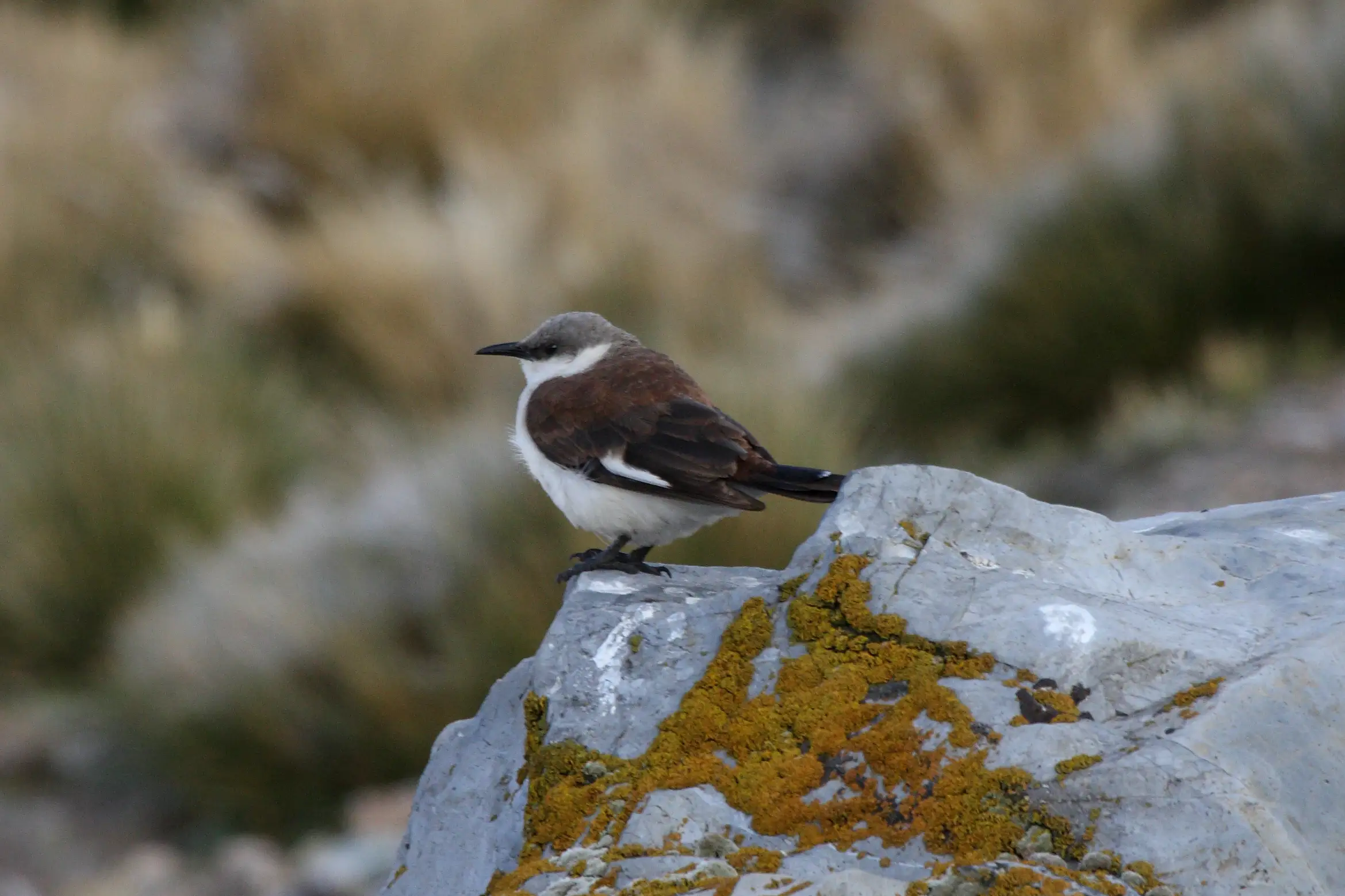
The critically endangered White-bellied Cinclodes thrives in the high-altitude bogs of Peru, showcasing its striking white belly. Photo by Dominic Sherony, under the CC BY-SA 2.0 < https://creativecommons.org/licenses/by-sa/2.0 > license, via Wikimedia Commons .
Lulu's tody-flycatcher is a jewel of the Peruvian cloud forests, captivating bird enthusiasts with its vibrant plumage and unique charm. Endemic to northern Peru, this tiny bird inhabits the lush montane forests of the eastern Andes, typically between 1,800 and 2,500 meters (5,900 to 8,200 feet) above sea level.
This flycatcher is easily recognizable by its striking coloration. Its fiery orange crown contrasts beautifully with its olive-green back and wings, while its bright yellow throat and underparts make it stand out against the dense greenery of its habitat. A black mask across its face and white streaks on its wings add to its dramatic appearance.
This species suffers habitat loss caused by deforestation and agricultural expansion in its limited range. Conservation initiatives aimed at preserving cloud forest habitats are crucial to ensuring its survival.
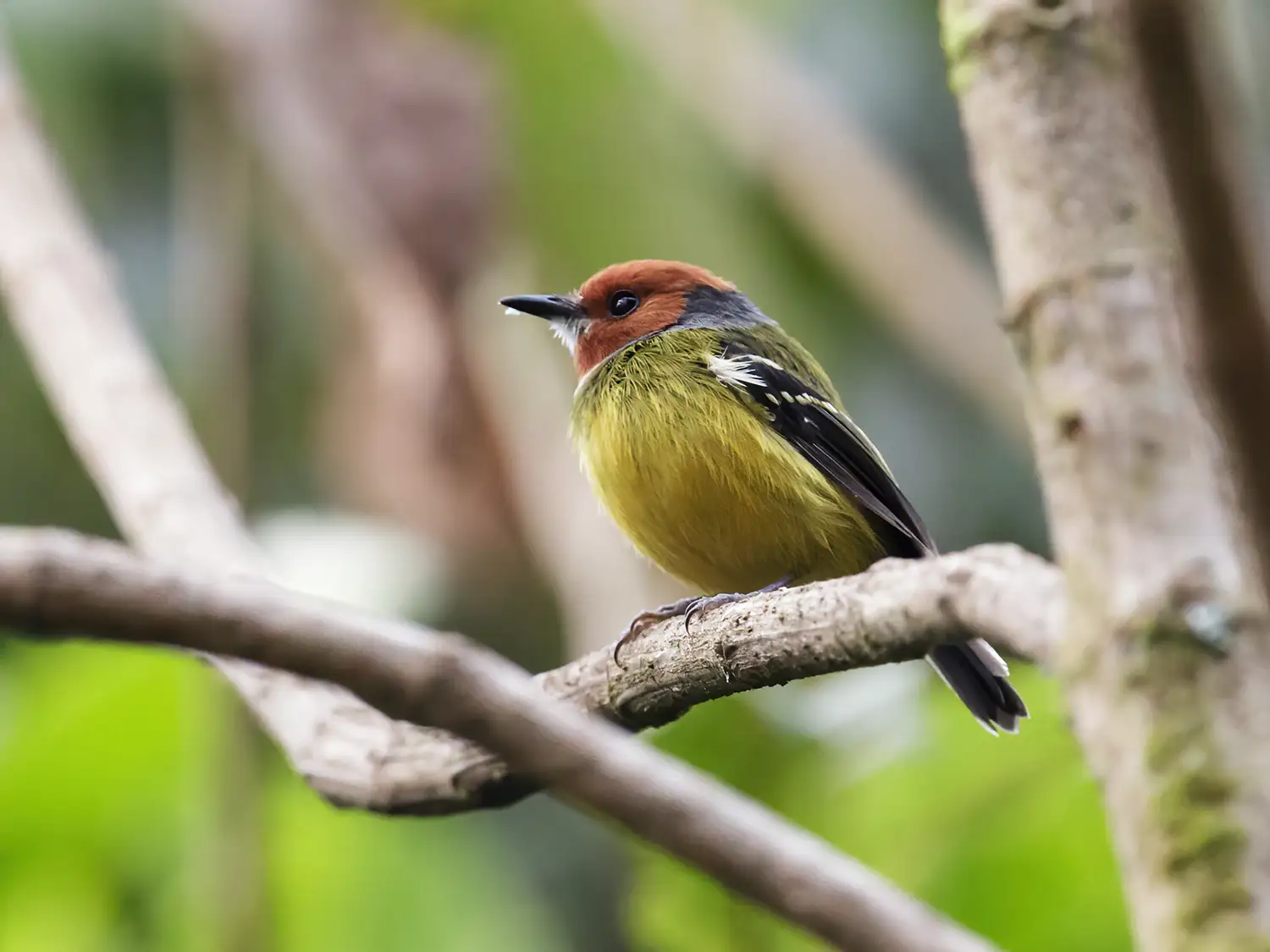
Lulu's Tody-Flycatcher, a tiny bird with striking black-and-yellow plumage. Photo by Nick Athanas, under the CC BY-SA 2.0 < https://creativecommons.org/licenses/by-sa/2.0 > license, via Wikimedia Commons .
Peru's rich biodiversity and incredible bird species make it a dream destination for birdwatchers. With the right preparation and guidance, you'll have a memorable experience exploring the country's avian wonders.
The best time for birdwatching in Peru largely depends on the region and the species you hope to see. However, the dry season, which runs from May to October, is ideal for many birding destinations as there is less rain to disrupt outdoor activities. This season is especially great for visiting the Andes and the Amazon rainforest, where bird activity remains high, and the weather is more accommodating for treks and exploration. If you’re targeting migratory species, consider visiting during the shoulder months of April or November, when birds are often more active and visible.
To fully enjoy the birdwatching experience in Peru, having the right gear is essential. Here's a list of must-haves:
Hiring a local guide can significantly enhance your birdwatching experience in Peru. These experts have an intimate knowledge of the area's ecosystems, know where to find specific species, and can identify birds by their calls or subtle movements. Local guides also contribute to conservation efforts and sustainable tourism by sharing the importance of protecting habitats and fostering community support. Many lodges and reserves, especially in the Amazon and Andes, have experienced birding guides who can take you to hidden spots and provide fascinating insights into bird behavior.
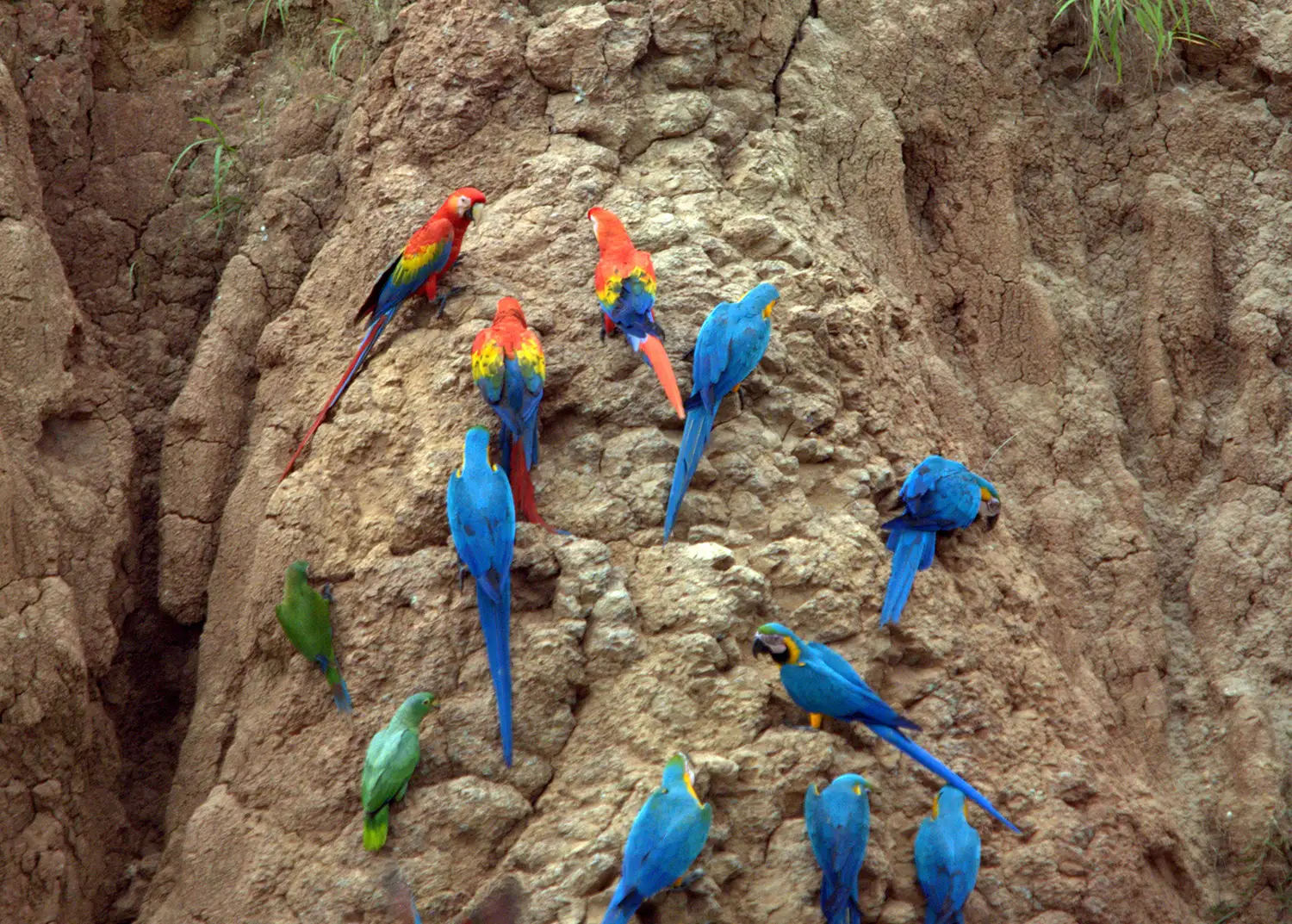
Scarlet Macaws, among other parrot species, perched on a clay lick in the Amazon rainforest. Photo by Brian Ralphs, under the CC BY 2.0 < https://creativecommons.org/licenses/by/2.0 > license, via Wikimedia Commons .
Whether you’re a seasoned birder or just starting out, these helpful tools and resources will help make your Peruvian birdwatching adventure both enjoyable and productive:
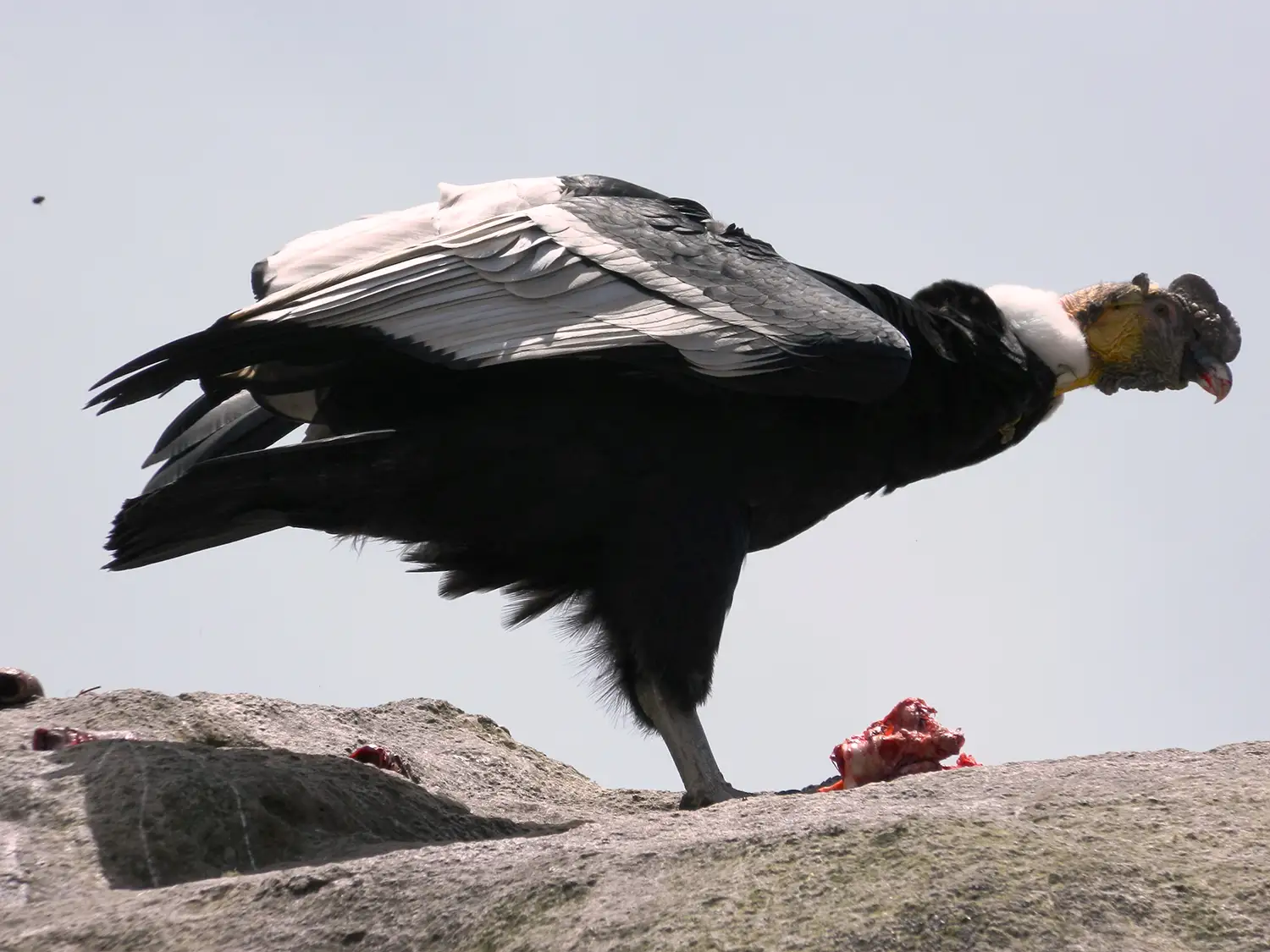
An Andean Condor feeding on carrion in its natural habitat. Photo by Popayánturismo, under the CC BY-SA 4.0 < https://creativecommons.org/licenses/by-sa/4.0 > license, via Wikimedia Commons .
Peru offers some of the most diverse and breathtaking birdwatching experiences in the world, making it a must-visit destination for any avid birdwatcher. From the vibrant cloud forests of Mindo to the high-altitude grasslands of Ticlio and Junín, the country is home to a staggering variety of species, many of which are endemic to the region.
Whether you're spotting the majestic Andean Condor in Huascarán National Park or the colorful Marvelous Spatuletail in the Amazon Basin, Peru's birdlife is truly unparalleled. Beyond the birds, you'll immerse yourself in the stunning landscapes, rich culture, and unique ecosystems that make this country a top destination for nature lovers. Add birdwatching in Peru to your bucket list for an unforgettable adventure!

Dean is a South African animal lover, travel enthusiast, and writer. He worked as a safari guide in Kruger National Park for 27 years. Following his heart, he moved to Peru to be with his wife. Dean's passions include animals, tourism, writing, graphic design, and web development. In his free time, he enjoys movies, books, and spending time with friends and family.
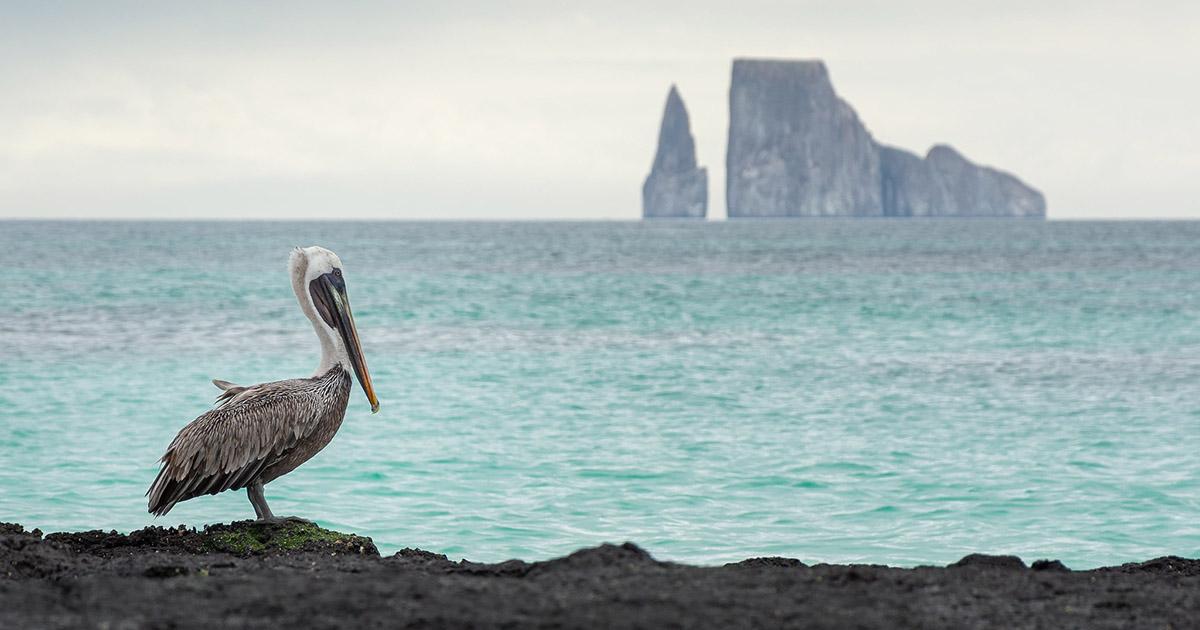
Over 500 miles from the mainland, the Galapagos Islands are at the very top of the list of must-see places in Ecuador. The diversity of species seen on the Galapagos Islands is rivaled by few places in the world. There are so many unique species of flora and fauna scattered across the archipelago that to ask which are the best Galapagos islands to visit would be unjust. Instead, we have put together our list of top things to do in the Galapagos Islands that are sure to entice all types of travelers visiting a range of islands.
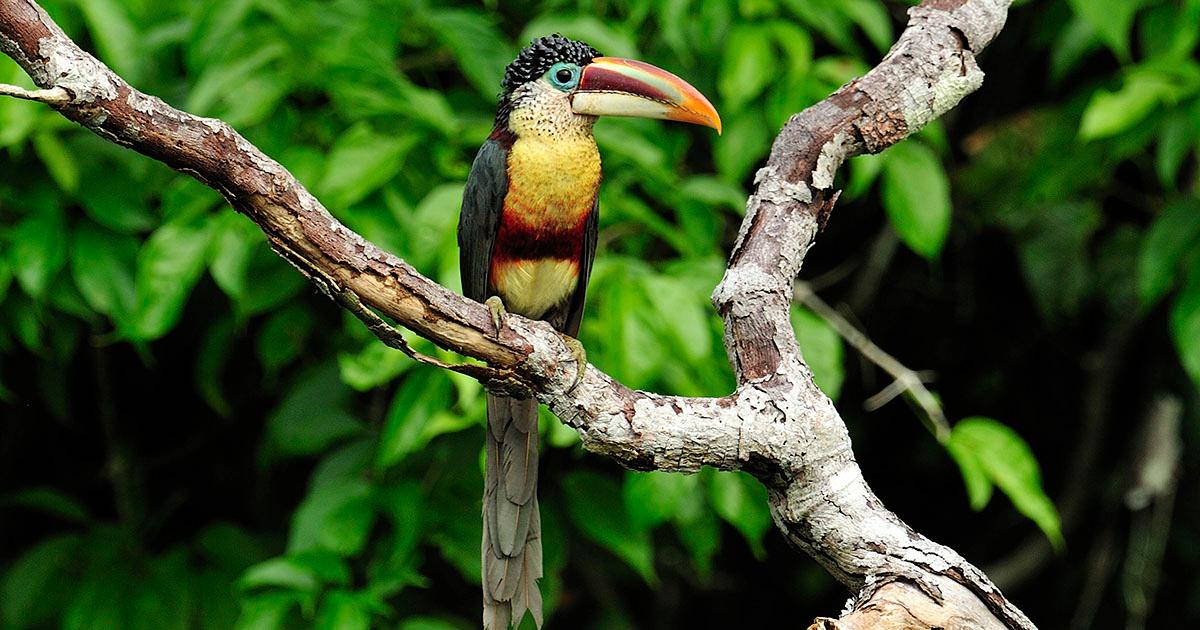
Peru is considered a megadiverse country, as along with sixteen other countries, it contains more than 70% of the planet’s biodiversity. An impressive 1,869 bird species are found in Peru—the second-highest of any country in the world. Consequently, birding in Peru plays a vital role in its tourism sector. Three distinct birding routes (Southern, Central, and Northern) have been developed for Peru’s tourism.